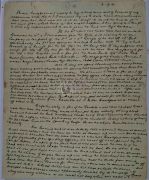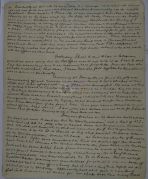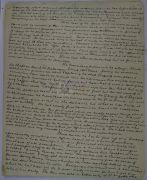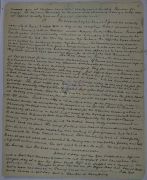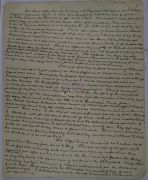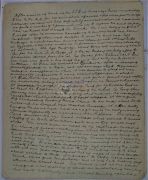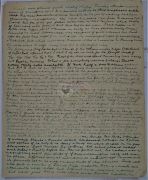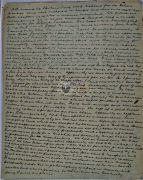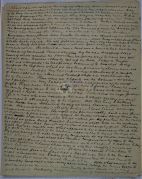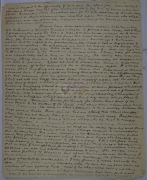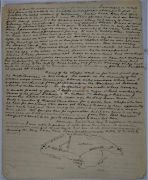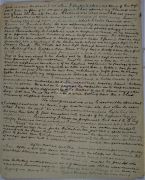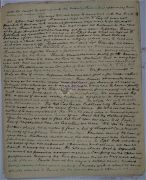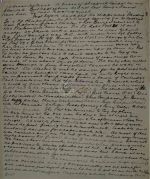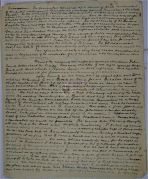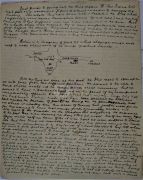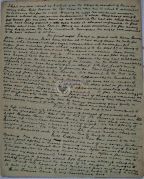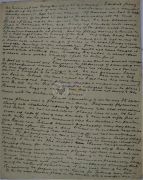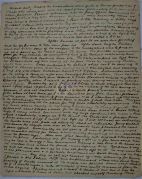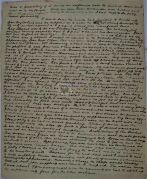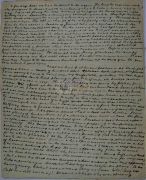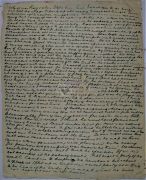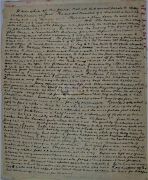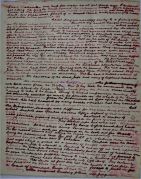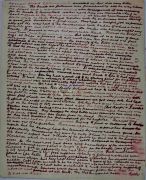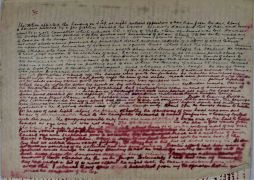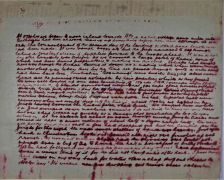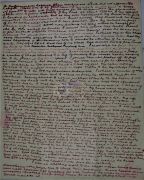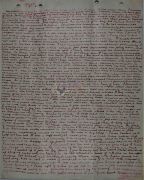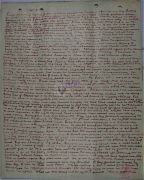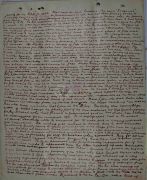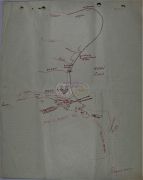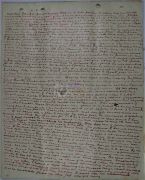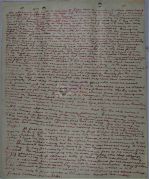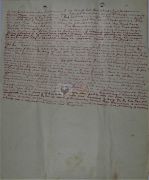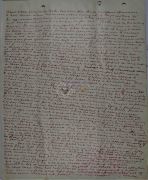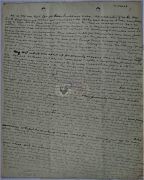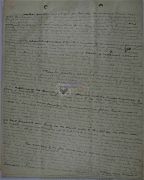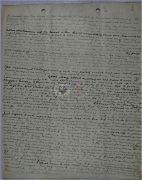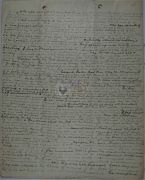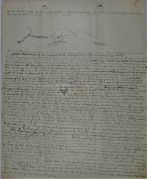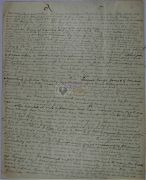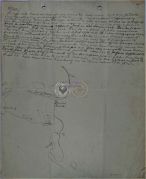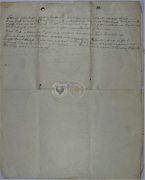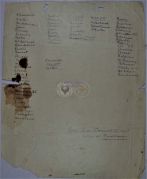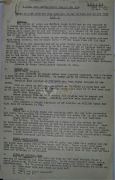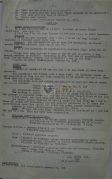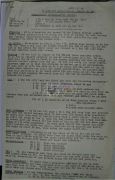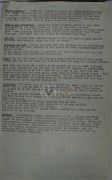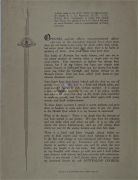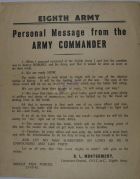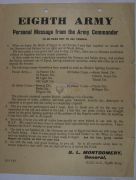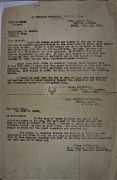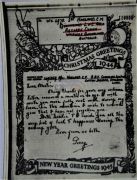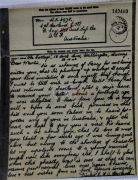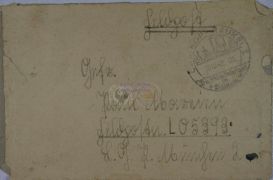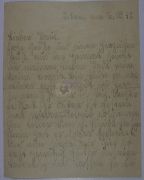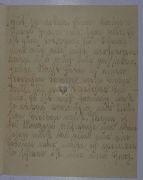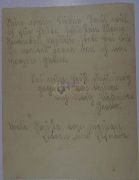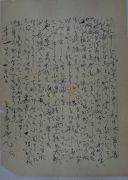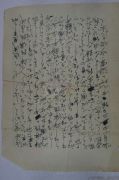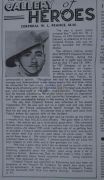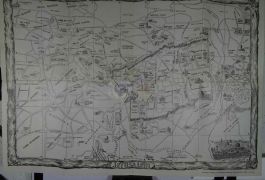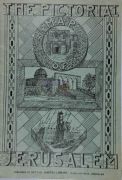HARLAND, Charles Arthur Martin - WX6978
| Original items held by the Army Museum of Western Australia |
| Conflict | World War 2 |
|---|---|
| Service Arm | Australian Imperial Force |
| Unit | 2/28th Infantry Battalion |
| Service No. | WX6978 |
| Service Arm | Army |
| Date of Birth | 27 June 1903 |
| Birthplace | London, ENG |
| Residence | Subiaco, Perth, WA |
| Date of Death | 22 July 1979 |
| Relatives | Wife - Hilda Thornton |
Diary dated 6 July 1941 to 5 November 1943
Part 1
6-7-41
I have long promised myself to try to keep some sort of records of my experiences with the A.I.F. overseas but up to date have done nothing
in that direction but now we are on draft to go up the line to join our unit, from which time a lot might happen, I am going to attempt to
write my experiences up to date from the time that we left Northam.
It's the 14th April & we know now that we embark tomorrow the 15th & I can assure you the boys are raring to go. Our Company is composed of the 3rd 4 & 5th Reinfts of the 2nd/28th Batt. of which only the 3rd are going on the trip together with the 'A' Coy which consists of a Reinft for the 2/11 2/16 & the 2nd Reinf 2/28. 'D' Coy supplies one reinft for the 2/16 & 'B' Coy one for the 2/11 So in all we have two reinfts each for 2/11 2/16 & 2/28 together with a few for the Anti Tank 2/3rd Field Reg. Mobil Laundry Mobil Bath & Salvage - The draft of the Western Command under Major Hubert Parkes Mjr Harburn Capts Lynas, Albrecht & Preston All today we spent checking over everybodies gear, making good shortages etc seeing that everybody had their teeth OK & that their paybooks were in order. We planned to have a few 'send off' drinks tonight but about eight oclock the pay office chaps came along & checked everybodies paybook to assure they were in the correct hands & to issue a slip to be inserted in the book. This had to be left protruding from your paybook in your lefthand breast pocket so that it could be taken from you as you embarked. This of course was to ensure that only the correct personnel embarked. After all this was over the Canteen was so crowded that it was an ordeal to get even one drink let alone a few. Perhaps it was just as well, for we had a very strenuous day ahead of us. Reveille at 3.30AM breakfast at 4. & move off about 4.30.
Unfortunately a few of the Rowdies must have managed to get more beer than the rest & they made it their job to see nobody got any sleep. Running through the huts dragging chaps out of bed & heaving their blankets into the rafters & their paliasses out of the window. To say nothing of throwing the garbage tins on the Lavatory Roofs. So on the whole Reveille was none too early. On turning out it was bitterly cold & around dawn it seemed to get even colder but by then we were so loaded up with our packs which included a blanket that we were glad it was cold. Breakfast over & after a few farewells from our staff officers we moved off accompanied by the Camps Pipers. In spite of the fact that it was still dark the roads of the camp were lined with chaps wishing us all the best. As we got on to the road it was just light enough to see the line ahead & it was strange to see the chain of smoke going up all along the line as the men were told they could smoke, for the cold atmosphere kept the smoke from rising. There were two trains leaving for Fremantle & ours was the second one di[torn page] leave at 10 to 7. Whilst collecting our Kit bags outside the station [torn page] brought along scones & cakes apparently donated by so thoughtf[torn page] & they were very welcome a we could not say when our next [torn page] be. Eventually we got into the train six to a carriage which what with all our gear etc was quite enough & we played pontoon practically all the way to Midland. From there on to Fremantle it was wonderful to see & hear the people cheering us as the train went by. The little old lady living on the right hand side of the Railway somewhere between Maylands & Mt Lawley if I remember rightly is worthy of special mention. She was a great patriot & during the happy times on our trips to Perth on leave she was always there to give us a wave. I think she kept a flag on the verandah handy for the job. On this occasion however she excelled. She must have known we were going to pass by on out way that day & she put on a great show. Then there were some nurses assembled on the railway Bank with a canvas painted 'good luck boys'. All this was more cheering than I can express. It certainly makes one feel that we have left people behind who are worth all the effort we can give. Yesterday I tried to send Hilda a telegram saying we were going but the Post Office would not take it so I had to send here an irreverent one & on receiving her first letter 3 months later she said she understood. Poor dear, I know how she felt but like the hero she is she is taking it smilingly.
Arriving at Fremantle we found the jetty was barracaded off with crowds at the barrier tryng to get a glimpse at their chaps but I am afraid not many of them were successful. We were not long in getting aboard a tanker which was acting as a lighter but we were a long time pulling out to the ship which was anchored out in Gage Roads. Two or three women braved everything & managed to get through the barrracade & alongside the lighter & were singing out for their husbands but I am doubtful if they found them. One poor woman seemd to be just about off her head over it. I am jolly glad Hilda was not there for I should never have forgotten having such a last look at her. From our position on the boat we could not see the boat we were going to sail on but the "New Amsterdam" with a load of N.Z.s was tied up at the jetty also a naval boat but the rest were anchored out. We did not know which ship we were due for but conjecture was that it was to be the "Il de France" a big ship painted the same colour as the "New Amsterdam" brown & black, as I remember the Ile of Benalla was painted. After some considerable time we pushed off & you should have heard the cheering & cock-a-doodle dos from boats in the harbour. I noticed the boom pulled back from across the mouth of the harbour as we passed through & gradually everything on the wharf became undistinguishable & we drew alongside the "Il de France". Then we kept huddled together guarding our gear & Kitbags frightened to take our packs off in case we had to move off in a hurry but it was a long time before we did at last go up the gangway. Apparently there were quite a number of South Australians on board for our chaps gave them many Crow squwarks, which received appropriate response from the heads protruding through the thousands of port-holes & from the decks towering high above us. Whilst waiting we pumped the chaps already on board as to how the tucker was etc. & their replies were none to reassuring. I noticed that nearly everbody on the boat was wearing or carrying a life-belt. At the head of the gang-way we were given a card with the number of our accomodation deck on & made our was there through mysterious passages & at last found our quarters, - a portion of "C" Deck on the portside forward. It was one mass of hammocks hanging from the roof with tables underneath. There were racks above the hammocks for our gear. The hammock hung so low that it made the tables useless but we soon got used to these new conditions. I bagged a hammock next to a porthole and thought I should be OK. After falling out a couple of times - not whilst asleep but while trying to climb into this thing I got quite used to it. We appeared to me to be terribly crowded but whilst we were in Fremantle we did not notice it as the black out was not on. It was Wed. when we embarked but we found we were not leaving until the Saturday.
The Mauritama pulled into the wharf & I think the chaps on board (N.Zealanders I think) got leave. Having got ourselves settled in our quarters we went exploring the ship. Picquets were placed everywhere & you could go through here, no admission this way etc till one became quite bewildered but we found out later it was sort of a one way traffic & that you could go practically anywhere you liked but only by a certain route. Confusing & annoying at first but you get used to it. From the decks we could see the complete convoy the Q Mary, the Q Elizabeth, the New Australian, the Mauritana & the one we were on the Il de France. We could see something of our escort in the distance but what or how large it was we couldn't say. We had nearly five thousand on board & the meals were done in three sittings. Our first meal which we badly need came about two oclock & we then saw the wonderful dining hall used for the men. I cannot describe it in detail but when I say that something like 1500 men dined at it a once you can guess something of its dimensions & I would dearly have loved to have seen through the Kitchen which apart from cooking for the men also catered for another Dining Hall for Officers & Sergeants. The meals were good, well cooked but very crowded & rushed, & at times rather light on.
I think this was Il de F's first trip as a Troopship & practically everything was left on board as it was in Peacetime. There was a huge beautiful Lounge furnished almost entirely with armchairs of all decriptions. It seems a terrible shame to sacrifice such beautiful stuff to the tender mercy of soldiers but I suppose it can't be helped. Another lounge was soon converted into a Casino & soon became so named. Every night there was a roar coming from the games of Banker, Housy Housy, Crown & Anchoy etc. I saw one chap betting in fivers too but don't know how he got on. Everyone was issued with a beer ticket which he had to get his O/C to sign daily in order for him to get one bottle of beer daily. The beer was sold in bottles only 10c per bottle & the queue at Canteen hours went nearly round the ship. However for myself, the beer was usually on the warm side & drinking it out of a bottle does not appeal greatly to me so I did not indulge much. The second day on board I found the orderly room where I was to work was a bay in the reception Foyer devoted to the Western Command, all in together under Majors Parkes & Harburn. From what I could gather it was originally intended or anticipated that we should be divided in two lots the 2/11 & 2/16 under Mjr Parkes & 2/28 & the 'Odds & Sods' as we called the balance under Mjr Harburn. As however we were both on the one boat there seemed to be quite a bit of discord as to who was in Command neither Major caring to give way. Eventually however they appeared to have compromised & Maj Parkes seemed to have gained his point for he virtually took Command.
The three days in Fremantly soon passed & we at last set sail for our unknown destinations. Of course rumnours were rife as to where we were going but my opinion eventually proved correct. The trip on the whole was entirely uneventful. Very few were sea-sick and the sea was remarkably calm all the way. Just before leaving Fremantle they hoisted the Paravanes overboard & I think one of them got smashed on a rock or something & they had to be hauled in again & so we travelled without them, but we followed directly in the Q Marys wake so she did the job for both ships. The first night was tolerable even with the black-out on & all portholes securely closed & blacked out but after that it was like an oven. The promenade deck was the only one we could use & was completely closed up. Nobody was allowed on the open deck at all except those on look-out or A.A. duties. There was also a no smoking order for the promenade decks or between decks, so everybody congregated in the Lounge Foyer or Casino. Obviously the ship was originally intended for the Atlantic crossing which is generally speaking a cold trip & most of the lighting arrangements seemed to be devised to provide both heat & light. Consequently both the Lounge & Casino became very bad when we go into the tropics. Every body walked around in shorts boots & no shirt. The worst feature was that it was impossible to escape from the heat. The ships ventilation was working at full pressure but had no chance with the huge crowd on board. Still everybody took it cheerfully. Once at sea we were instructed to carry our waterbottles filled, our hats & life belts with us always. We got used to it in the end. We had pictures in the Lounge but the heat made them unendurable.
About 5 days out The New Amsterdam left us with a boat that came out to escort her into Singapore & we carried on. On Anzac day at 11am the four boats left all stopped and turned in the form of a cross. I thought at first this was for the Anzac day but heard later that a man had died on the Q Mary & was buried at that time. I do not think he was a soldier but a barber or something. Not long after this the Q Mary & Q Elizabeth left us as I believe they had sufficient water to go straight on whilst we had to pull in to Colombo with the Mauritana for water & oil. We sighted that port the next day & pulled into the harbour soon after midday. They had quite a bit of trouble getting us into position too for I think we must have touched bottom by the mud stirred up. I think apart from of course London, Colombo is the busiest port I have seen for ships were coming & going all day long. One anchored next to us had a huge hole in her bows. I was told she got in a collision, but she was well armed with guns & think it quite possible she had been in a scrap. There is apparently no jetty at Colombo & all the loading is done by lighters & its wonderful to see the small & very fast craft that ply through the harbour. The natives in their small boats swarmed around the boat with fruit & souveniers to sell. It must have been a harvest for them. The prices of their goods obviously soared for our benefit & thus the boys had their first experience of bargaining.
I cannot give here a full account of Colombo but we managed to get ashore on three different days during the ten days we were there. Generally the people treated us remarkably well although I noticed some reserve is some quarters as I think they recollected an earlier convoy. The local planters placed buses at our disposal & organised trips for us & on the who we thoroughly enjoyed it. I think the worst feature of the place was the begging by the kids. In spite of the very strict surveillance of the native police they mauled you around terribly & you soon learned where the word 'Buckshie' came from. The local native soldiers were amusing & they made every effort to give us to understand they regarded us as brothers united in a common cause. Beer was to be had a varying prices ranging from 65 cents to 150 cents, all for the same brands of beer, which was mostly Scotch. There are some beautiful Hotels there but the coloured Stewards seem to be under the instructions to get what they can out of you. They got very little as we could only draw a pound each. During our stay there the weather was particularly hot & sultry but we were allowed to sleep on deck so it was not so bad. The Acquitania came into the harbour there & joined our convoy from there to Suez. The remainder of the journey to that port was entirely with out incident of any importance. One morning just after we had entered to Red sea we passed the Q Mary on her way back & the same evening we passed the Q Elizabeth. We pulled into Suez early in the morning & I was astonished to see the collection of ships there. There seemed to be literally hundreds of them of all shapes & sizes. I believe there was a large American convoy in or something.
After arriving back at the I.T.B. at Mughazi I was immediately sent to the M.O. for examination & passed as fit & put on draft. Although we were not told definitely our destination we had with us quite a number of X personnel who were to rejoin the unit so from them we know that it was to be Tobruk. The main body of the 2nd & 3rd Reinfts after the numerous transferring to sundry units had been completed 83 whom were suitable to join the unit had left Mughazi a month earlier during my absence with 1st Aust Corps at Nazareth & we were under the impression that they were already at Tobruk. We left Mughazi about 30 in all including about 10 for the Anti Tank Corps, at 7pm on Friday 17th July after a farewell speech from the Col. Col Sparks from Queensland. In all there was quite a big draft leaving but only the 30 for our battalion. At 5am we arrived at Qantarra after a wearying packed in a train with all our gear & Kits. Men were asleep in every place in which it was possible to sleep & it was practically impossible to move without stepping on a sleeper. At Qantarra we were provided with quite a decent meal & after the inevitable delay crossed the canal in the Ferry & entrained for Amorya, the staging camp for the Middle East or at least the Egyptian & Lebanon portion of the M. East. A long slow slow journey was quite interesting as we went through the wonderfully irrigated & cultivated parts of Egypt & stopped at some quite big & interesting looking towns. Came to an end about 20-30 miles into the Desert, & we reached Amorya at 4pm pretty hungry too as we had had no meal since the early morning & found difficulty in eating our Iron Rations. The staging Camp surrounds an Arab village which seemed to consist chiefly of a Date plantation with one or two small Arab shops. We were given a meal at the railhead consisting of a chunk of bread & watery stew which being hungry we quite appreciated. Lt Hickey then told us that we were going into tents temporarily & would probably leave again to catch the boat either in the early hours of the morning or at 3pm the next day. It was an endurance test marching the mile and a half from the station to the tents where we were to stay with all our gear & equipment but we made it in due course & were allotted to tents. I managed to bag a home made bunk & was quite comfortable but it was here that we first struck the desert dust. The desert is not as one would imagine vast stretches of sand in undulating country but more extremely hard clayey country rather like marl & in places quite rocky & hilly. Trucks & troops moving over it grinds the soil to a powder as fine as flour & in places ankle deep. The ever prevailing wind completes the job of making the place generally uncomfortable. We had tea & were then free to roam the Camp but few of us got further away than the Wet Canteen where bottles of beer were sold from a tent two bottles per man. I had supper in a little Wog Coffee joint & turned in early as I was feeling pretty tired. During the night Alexandra was recipient of quite a decent air raid & for the first time most of us witnessed the wonderful sight of search lights & Ack-Ack fire which included tracers & what is known as the 'Flaming Onions'. We were about 12 miles away and got a wonderful view.
The following day I was put in charge of the Op Room under Major Ligertwood of the 2/43 Batt & found that I had to do all the work for the Reinfts drafts of the 2/32 2/28 2/43 2/12 2/13 & 2/17. Most of the day was spent converting their money into Egyptian currency. What a job everybody wanting to change small money & only notes available. It took half a day to clean out a tent fit to use as an office. Towards evening we were placed on 2 hrs notice, meaning we were to be prepared to move out at very short notice & later we were told we were to leave early in the morning. Lt Hickey warned the party not to attempt to take any liquor with them, a proceeding which I later found to be a very wise one. We were up bright & early in the morning had a hurried breakfast & were enbussed in Transports for Alexandria. In spite of the overnight warning a number of chaps had cleared off to Alex. overnight A.W.L. of course & were in a half enebriated condition that morning. The Officer managed to locate a bottle of whisky which I.L. had apparently intended to smuggle on board with him & tipped it out. For a time this caused quite a stir amongst those concerned, & dire threat were made against that Officer. The trip into Alex. was quite uninteresting for the most part. The first 10 miles or so being practically all desert country within the exception of a salt lake which appeared to be a vivid beige colour, I suppose caused by the salt. Nearing the city we passed the Road to Meisa Matruh, & from then on the road was lined on either side with Military Depots Ammunition Dumps Car Parks & Dumps of wrecked planes & trucks galore. We passed through the Native Arab portion of the city to the docks & there we were dumped on the quay alongside a Light Cruiser the Lotana. We went aboard without much delay & shortly before 10AM we pulled out. The Habour was a magnificent sight. War ships of every description were all over the place. I noticed several submarines an Aircraft Carrier with its funnels set on the side, & many ships of other classes. There were also quite a number of French ships capable looking vessels all apparently well kept but I do not think they were manned but were just being held there since France's capitulation.
All around the harbour there were balloons for the Balloon Barage. Some were anchored on barges & others on the shore. Ack-Ack weapons were also in evidence everywhere. We pulled out accompanied by a small destroyer loaded deep in the water with cargo for Tobruk I suppose. Our boat was a beautiful ship and the trip was its first Commission since arriving from England having only been launched in April 3 months previously. It had guns fore & aft & poppom ack ack guns on her upper decks. She was not heavily armoured as she was built mainly for mine laying & relied on her wonderful speed more than anything for her safety. However the guns she had looked quite capable affairs & the largest of them were used for ack ack work when occasion required. The gunners were at their posts throughout the whole journey. We were given life-belts which we carried with us the whole time which we were on the boat. Once clear of the harbour, the shiop soon showed us something of her speed (I believe she is capable of 46 knots) and it was not long before we had lost the little destroyer. There were about 200 troops on board including a few South African Airmen. Apparently we were only just a couple of days behind the main body of Reinforcements from our lot. For I found out later that the main body of the chaps whom I came over with had been kept in Amyira for about six weeks. The trip generally was full of interest & we all went about with life-belts slung over our shoulders. The crew treated us wonderfully & provided us with a couple of very decent meals & tea between times. Throughout the journey the gun crews were at their stations all the time & we almost hoped something would happen to draw them into action. There anti-aircraft guns were indeed various numerous & formidable looking. We kept up a solid bat all the way & about 4pm got an air raid alarm. Apparently an aeroplane from Sollum probably had been spotted on a reconniance. I was at a loss to understand why we had not been seen before, for we had been in sight of land which was occupied by the enemy, for a long time. However nothing happened at the time. After dark we all went below, as there was always the danger of somebody forgetting the risk & lighting up a smoke. Everything was quiet for a long time, but presently things began to stir in preparation for disembarking. We had on board some 150 to 200 tons of stores & ammunition which apparently all had to be unloaded by hand. We were taken up on deck & told that the facilities for our disembarkation were very uncertain, but that probably we would be leaving by the stern. Should this exit prove unsuitable from which to transfer us on to a tender we would probably have to us some emergency ladders which we were shown in order that we should know their locality. It must be realised that all this was necessary as the boat had not previously made this trip & the urgency of speed in disembarking & unloading was imperative as the harbour was constantly being raided by planes.
About 11pm we noticed the engines slowing down & guessed we were nearing our destination & it was not long before they stopped altogether. One of the crew cam below & told us we were just outside the harbour & an Air Raid was in progress & the anti-aircraft were blazing away like hell. It did not last long however for the engines soon started up again & we began to move at a considerably reduced rate to hither to. Within twenty minutes or so we stopped again & heard the anchor going down & a voice over the loud speaker which was apparently connected with the bridge said 'We're now through the boom & anchored in Tobruk Harbour'. Very soon everything was bustle, the stern was opened up and absolutely every member of the crew without exception was busy unloading flour shells bully beef etc. We all felt we were in their way & would like to have given a hand but were rigged out in our gear ready to move at a moments notice. For about an hour, there was a terrible hub-bub as the unloading continued caused chiefly by the men dragging steel boxes of shells across the floor & then we got the word to move & we got all our gear together & slowly got up on deck. I saw a tender tied up alongside & the troops were beginning to board it. To my surprise the ladders which we had been previously shown was not being used. Instead they had improvised a gangway of a couple of boards set an alarming sharp slope & a rope alongside as a banister. There were no cleats on the boards & as soon as I put foot on them I slipped. I think it was one of the worst frights I have ever had in my life, for had I fallen I would most certainly have gone to the bottom laden as I was with all my equipment Rifle ammunition Kit bag. I clutched the rope for dear life & a man who was assisting the men to alight grabbed me & I managed to get safely to the Lighter. All this time I believe other troops were boarding the ship we were leaving from the other side. Some six hundred, chiefly Indians I have heard, although we saw nothing of them. The night was particularly dark & one found it difficult to find ones way about the tender & scrambling down the iron steps was no joke. Whilst making for the position on the lighter to which we were directed I noticed a shell lobb in the distance but apart from that everything on shore was strangely quiet. The only light that was visible was what appeared to be a hurricane lamp, tied to a pile in the middle of the harbour apparently to direct the tugs etc. I had just managed to make myself as comfortable as my burden would permit when 'whoosh' a huge shell had landed comparatively close to the tender splattering its upper structure with shrapnel. Needless to say we all ducked in a hurry & there was a clatter & muffled curses as steel helmet met steel helmet. It was the nearest I had been to direct shell fire & the fact that a barge was tied to the tender right alongside me laden with ammunition did not tend to make us feel any the more comfortable. After what seemed to be a terribly long wait & apparently unnecessary delays the tender began to pull away from the mine layer & eventually pull alongside the wharf and landed. Actually the whole operation of disembarking & unloading was a credit to the efficiency of the Navy for apart from disembarking & unloading troops, they had also unloaded 200 tons of ammunition and stores. Necessary stores I realise now, for the whole garrison of Tobruk were dependant on stores & ammunition rushed up in this manner & the whole operation was completed & the cruiser was out of the harbour in something less than two hours.
It must have been somewhere around 0130 hours when we embussed in covered trucks & began to proceed, we knew not where. I personally was too tired to take particuler interest as to our route but remember that at first we must have gone through the town for I remember several dilapidated buildings & bitumen roads but the night was particularly dark & not a light was to be seen anywhere. As of course we had no lights on the truck the progress we made was little better than a crawl. Soon we left the bitumen & took to the bush (a courtesy I know now for there was absolutely not a bush in the vicinity) The going now was over rocky stoney country all the way but eventually we stopped and were told to get out. Next we had to scramble down a huge very rocky Wadi of what seemed to be bottomless depth. It was no mean feat lumping all our gear down this treacherous descent & several times I slipped with my heavy Army boots on the slippery rocks & on one occasion fell completely scattering all my gear. By the time I had got all my stuff loaded about myself again all the others were out of sight & I had a nasty feeling that I was going to get lost. Not knowing anything about one's destination or even present whereabouts even as to whether one is in a danger zone or not is not a pleasant feeling. All movement seemed to be very stealthy & everybody spoke in whispers which seemed to lend a eerie atmosphere to everything. However I was fortunate for I was best part of the way down to the bottom of the Wadi & the others were assembled there when I arrived. We were in what appeared to be the bottom of a valley between two huge rocky hills. Our guide led us along this about 400 yds & then told us we could camp any way around there. They pointed out several sangers to us & told us it would be best to occupy them. 'Sangers' a new name to me, probably needs some description. They are holes dug in the ground as deep as the rocky country will permit which is usually only 18 inch to 2 ft & large enough to accomodate one or sometimes two men around the hole rocky were piled some two feet high across which were put bags, old blankets or old Italian ground sheets to form a roof. I did not much feel like making a tour of inspection, so untied my rugs & spread them out in one I had spotted for myself & I turned in somewhere about 0400 hrs, in all my clothing needless to say. The sanger gave me some feeling of security but about ten minutes as long as I could stand in this particular one. To a newcomer the fleas made the place absolutely untenable & I was forced to move out into the open. I fell asleep & awoke when the sun on my face made me realise it was getting late. Most of the others were getting up & some had scrounged around a bit & discovered that water for a wash was to be had at a water hole surrounded by a few scraggy palms but the water was not fit for drinking. I managed a wash but found the water to be terribly mineralised & seemed to just curdle the soap instead of lathering. I went back to my Kit & found my blankets to be in quite a mess as I had spread my bed on some quite damp ground & the sticky red clay had stuck to them wherever they spread beyond my ground sheet. It was a wise plan to spread them out in the sun to delouse them a bit. So this done I proceeded up to the vicinity of the water hole where a meal was being prepared for us. It was a bully stew, watery its true but we were all pretty hungry so didn't worry much. After the meal we were told that we would probably be moving again after lunch, so we were more or less free to explore what we were told was the Staging Camp. We were in a valley between two very rocky & very tall hills. They were steep but not unclimbable. At one end was the sea & the other a basin formed by the escarpment. Wadis I later found were not hills or mountains but very deep probably extinct water courses. When down in them one gathered the impression of being in hilly or mountainous country but on climbing to the top of these hilly one finds oneself only level with the majority of the surrounding country - a plateau I suppose it would be called.
Many of the chaps went in for their first dip in the Mediterranean in this inlet. The rocks in the vicinity of the waters edge were covered in black oily residue which was I suppose washed up from the ships sunk in the harbour at Tobruk about 4 miles away. In the centre of the wadi where there as a small patch of sand I discovered a cross which marked the grave of the first Italian to be killed in Tobruk & that was I remember dated exactly a year ago the day I was there, July 20. Quite a number of Aussies came down here for a swim these chaps who had been here for sometime, & we got talking to some of them. Apparently their units had just come out of the front line & were having a day or twos spell. We pumped them for information but it was hard to get any real idea as to what was ahead of us from them. Still they were cheerful & seemed to be quite reconciled to their lot there. However I will here try to explain the position as well as I was able to picture it after some time there. A diagram will probably help but do not think that this is in any way accurate for during the time I was there I saw comparatively little of the whole line
Part 2
Well imagine the shock I got when I started to clean out some of the drift sand from the floor of the sanger & found I had spread my
blanket over one of those Iti tomato bombs. Whether it was alive or not I do not know but I shovelled it up with great care & dumped it
well away. Presently the enemy opened up with a huge gun, which I later learned was known as 'Bardia Bill'. He was apparently aiming at
something directly behind us & for half an hour or so shells whizzed over head consistently to explode with a deafening crack in the
vicinity of a square cement building some half mile away. The old hands told us he was shelling a water point & later I found he had
directed his attentions to the water hole we had just left in the Staging Camp. The chaps we had left behind turned up later & told us
the shelling had trapped them there & they had a pretty warm time of it while it lasted. I believe Jerry made a mess of of the water hole
too.
Just as tea was about to be dished out the Colonel & Adj arrived & we were paraded for his inspection. First he gave us a talk on things
in general explained something of the Routine explained the shortage of water & told us we would have to manage on little more than a
bottle a day for all purposes. At first I thought he had been imbibing a trifle from the whisky bottle, but now, after my experience in
Tobruk with him I do not in the least blame him if he had. I remember noticing a little circle of stones surrounding an undischarged red &
black Iti mortar bomb, between us as he spoke. He went on to say that he expected us to keep ourselves clean in spite of the difficulties
& he looked to us to shave every other day. All this time the old hands were getting their tea & I had visions of slipping badly.
The next proceeding was to sort out the specialists & I stepped out with the cooks sigs mortar men etc, but when he asked what I was he
said 'No orderly room vacancies, Rifle Coy you'. We were then told to fall oursleves into groups of the different Coys we wished to join.
Personally I have no preference but went to 'B' Coy chiefly because some rowdies I would rather avoid went to other Coys. 'Well' said the
Col said 'I am afraid you are rather unlucky to arrive at this time, for the Battalion has just had a spill & are moving into the front
line tonight. However', he continued 'its hardly fair to pitch you Reinforcements straight into the Front Line, so I'll see if we can get
you into a reserve position until you get acclimatised a bit.'
After that we got tea, curried sausages & rice pudding & tea. After a bit of a yarn with some of the chaps we turned in. The dust kept
blowing all night but we were tired & slept well.
Next day we visited the pay Sgt who was billetted underground and of course all N.C.O.s were reverted & we were Privates again. Sgt
George was in charge of the seven or eight of us going to 'B' Coy. Lieut Hickey told me he was doing all he could to get me into the
Orderly Room but apparently there were no vacancies.
We were told we were to move out into the line at 9pm that night. It seems that with 'B' Coy it was not possible to put us into reserve
positions & we were to go straight into the Front line. After tea that night we listened to the news at the Sig dugout & eventually got
our gear together. Our Felt hats we had stowed away in our sea kit bags which we had left at 'B' Eshelon & from then on we were never
without our Steel Helmets. At nine o'clock we got aboard a utility which was to take us out & we moved off. 'Cigarettes out' said Sgt
George as soon as we reached the Derna Road, which we traversed some way. Presently we left the Road & followed on tracks getting closer
all the time to the line. Things generally were pretty quiet. Now & again we heard a gun or two in the distance but a Verey light in the
distance was all we saw in the direction that we were travelling. I think the distance was something like 8 miles to 'B' Coy HQ & we
pulled up there about an hour later. We passed through a line or two of inner defence where we saw just a few troops scattered about
otherwise we saw very little. Our driver obviously knew his way or he would never have got there for driving at night in Tobruk was always
an ordeal & one had to have a pretty good knowledge of the track or one would find oneself into a tank trap over a precipice or
into a minefield. We arrived a Coy HQ a series of small rocky buildings roofed with bags & in places walled up with sandbags etc. The
whole let into the side of the escarpment. The Coy Comdr Capt (now Maj. Buntine came out to meet us & get the news from home. He told us
that we had nothing to worry about. The Iti's, he said were a cowardly mob & wouldn't come within Cooee of us. Don't let the shelling
worry you he said we get a fair bit but you get used to it. I asked him if they shelled them at Coy when we were. 'Oh yes' he said 'we get
our share, as a matter of fact a piece of shrapnel came through the roof of my place tonight earlier. However seeing the enemy were some
distance away and the escarpment was between I did not see much occasion. A Cpl led us along the edge of the escarpment & pointed out
where we could camp among the rocks. He told us it was best to separate as much as possible & recommended camping in the open in
preference to using the two sangers there as they were alive with fleas. I took him at his word & settled down among some rocks & was
soon asleep. I awoke with a start as some shells started to land on the escarpment opposite & at no great distance. A piece of shrapnel
landed on my blankets. But the shelling did not last long & I must have been too tired to worry much.
Just before daylight the chaps were 'Standing To' & the chaps from the posts were coming in to collect their Rations of food & water & Ron
Bain & I went out to No 11 Platoon with their men. The Pl held post 25 & another 27 I think with a section in the rear behind Coy. Lieut
Hannan was O.C. with under him Sgt Lally & Cpl France at Pl HQ Bruce Hill (Cpl) in charge of the Sec at Post 27 & Blue Edwards (Cpl) in
reserve with a section. Ron Bain & I were put on Pl HQ strength as runners & were told we could occupy a two man sanger on top or go down
the Post. To enter the post one had to climb nearly to the top of the hill & go down the man hole by means of iron rungs let in
the side it was about 20-25 ft down. The only other outlet was through a fire bay which covered the wadi in front. We elected to use the
sanger for the post was only small & was crowded & was dark the only light was an improvised lamp made from a sawn of cartridge case
inserted in the lid of a tobacco tin through which a wick of gun cleaning flannel was place & this rough light had to be carefully
shielded. The remainder of the HQ were Norm Barron (now PoW) Bill France (RW) Des Lally (killed) McCracken (killed) Blue Compassi, Jim
Bruce, Syd Halse, Charlie Warburton (PoW) & Bill Redfern (PoW) with Pat Hannah's batman Paddy Kearney & Percy Welles AAMC stretcher
bearer. The Post was connected to Coy by phone. We took turns at Gd one man by day & two at night one used to get an hour in the morning &
afternoon & two hours at night. At night from 9-12 we used to do a spot of work about the post fixing wire entanglements traps etc &
building sangers for weapon work etc. As most of this was carried out on the top of the hill which was covered by the enemy by fixed
lines of machine guns, I was not too keen about this work especially when picking rocks. The pick used to strike sparks as it hit. On one or
two occasions the Iti Asty opened up on us but I think it was only random shots for although several landed close they did not continue.
The enemy were located on high ground some 1100 yards away & occasionally as we went for our rations just before dawn he had gob at us
with MGs but we did not suffer a casualty whilst occupying this post.
The perimeter consisted of a series of posts constructed of cemented underground tunnels at vantage points throughout its whole length. In
the vicinity of Post 85 the country was deeply cut about everywhere & one went out of one wadi into another. Here the country was
comparatively easy to hold & in consequence the posts did not accommodate so many men & were some distance apart. In the vicinity of the
Bardia Road the country was much flatter & the posts of necessity were bigger & closer together. In the centre or rather slightly West
of the centre the Germans had broken through the outer defences & held the posts against us & also the very dominating country of a range
of hills immediately behind where they held an Italian fort which we had named Fort Lloyd (after Col Lloyd I believe). From this vantage
point I am told Jerry had observation of practically the whole of Tobruk. The El Adam road, I am told, led to the El Adam aerodrome which
was held & much used by the enemy.
I am afraid this is only a very brief & vague description but used in conjunction with the remainder of my narrative may convey some idea
of the situation generally.
During the morning we inspected several abandoned Trucks dotted about the wadi. They were vehicles of all sizes several huge Fiats with dual wheels & Pirelli tyres on, still inflated. Some had the bodies smashed up for firewood or covering sangers. After lunch we all assembled at about 2pm & three utilities belonging to our Battalion came for us. But alas three of the chaps couldn't be found & after a wait of over an hour we had to pull out without them. Two of them were chaps rejoining the unit so we guessed they knew their way abouts at least better than we did. We had another ordeal of a trip climbing up out of the wadi over the rocky country on a track that had only been made by the trucks themselves. Each truck travelled in a huge cloud of dust which its motion created & we were thickly covered by the time we arrived at 'B' Eschelon. This was a far from kindly looking place. It was on the top of the plateau & comparatively level with just an occasional fold in the ground. Apparently most of our vehicles were parked here scattered over a large area & concealed as much as possible. The wind was blowing strongly all the time & the dust was drifting constantly. It piled up against every stone & obstacle in its way & moving vehicles kept it going until the air was thick with it. It was some sort of limestone country & constant traffic powdered it so fine that to cross a track one had to wade ankle deep in a flowery dust. We were told we would be there for the night at least so Bedwell & I began to prepare a bit of a sanger for ourselves digging of course was out of the question but we had to have some sort of shelter against the wind & dust for no sooner one put a haversack or overcoat or anything else down than a pile of dust began to pile up against it. So we got together a pile of rocky & formed a sanger big enough to hold us both it had no roof but was a help against the wind & dust. We had been strongly warned not to meddle with anything as the place was alive with live Italian bombs grenades etc. & many chaps had been killed by stubbing their feet up against them etc. So you can [missing section]
Just prior to going into the line again 'B' Coy I was told had put on a wonderful fighting stunt in order to harass the enemy. The whole
Coy had gone out & tackled the Iti's & had inflicted very severe casualties (some 70 all told) and the only casualty B Coy suffered was one
man wounded in the arm. But the whole show was marred by a very unfortunate accident just before the stunt. They were getting ready to go
out & one of the chaps put a Bren gun across his shoulder & pulled the trigger. The gun was loaded & two chaps were accidently killed.
Below is a diagram of Post 25 which although rough will help to make clear some of the things of which I write.
[diagram]
All the time we were at this post, the Iti's used to open up on us with guns from two different positions. He seemed to be able to land
shells right up the wadi & with great accuracy but he seemed to have a particular set up on the point of the escarpment immediately
opposite our post about 100x away. I was told that on captured Italian maps that had been secured Italians had marked the position of Post
25 as being on the point opposite that in which it really was an error of course but just as well for us for they seemed to have that
range pretty accurately worked out. We used to go guardo in the Weapon Pit adjoining the entrance to the post, one man during the day &
two at night. Half an hour before dawn until half an hour after it was light we were supposed to 'Stand to' but this time we usually
occupied by going round the track around the escarpment a distance of about 800 yds to Coy HQ where we used to fill gallon petrol tins
with water which together with the days rations we used to carry to the post. I was always keen about getting back before it got light
because then he used to have a bit of a go at us with machine guns. I do not know if he actually saw us but rather think he did. However
one day he put five shells right in the middle of the track. From then on we usually elected to go over the top of the escarpment. It was
certainly more exposed but there was more room to move about that on the side. Every night six of the platoon used to go out through the
wire entanglement in front of the post and in the wadi as a Listening Post. My first night on this job needless to say I was not very keen
about. We used to follow a track up the Wadi for about 600 yds where it forked & we had the choice of which side of the fork we took. Every
night just before dark the enemy used to set up artillery somewhere up one of these wadi's always trying his gun out with a burst followed
by a single shot. I had my own ideas as to which was the wadi he occupied so I was not sorry when Bill France the Cpl chose the other one
in which to establish the Listening Post for the night. During the night two remained awake on guard while the remainder endeavoured to
sleep. Sleep wasn't easy to get though for one was bound up in webbing tin hat etc. which combined with hard rocky ground & cold made it
almost impossible. A few shells went over our heads going in each direction & a few enemy verey lights were the only incidents throughout
the night & we returned to the post about 4.45am.
The first night I went on guard with Norm Barrow from 1am-3am. I had been woken up & had sung down the hole for Norm & he emerged sleepy
eyed & scrambled into the weapon pit. Within five minutes from what appeared to be post 27 a string of white tracer bullets went out &
then some in return. Soon there was a real hub bub going. It was not the next post but the one beyond held by the Indians. Apparently
they had established an outpost on the No man side of the Wadi on the Hill immediately opposite & from there they staged a stunt whilst
frightening it was a wonderful sight of fireworks. Verey lights, tracers, grenades, shells, Mortar bombs. We called to the O.C. & he came
up from below, to have a look. Apparently he tumbled to what was up & after a time decided we were not in danger of attack & would not
turn the chaps out. The show went on for about an hour & gradually died down to spasmdic shooting which also died down before we were
relieved. A few bullets whizzed over our head & an occasional fragment of shrapnel otherwise we got surprisingly little of the overflow
considering how close the show was. For some days after this the enemy gunners gave quite a considerable amount of attention to the
Indians outpost.
It did not take us long to get accustomed to the life & shelling etc & every evening several of us would climb into the Weapon Pit & do
a bit of Iti rousing with a Iti Light Breeda Gun. Several times we saw our shots rouse some of them up & send them hurrying out of sight.
We had plenty of Breeda ammunition & used it more for fun & practice than anything else. We also had an Iti 2 inch mortar which we used to
practice with & a box or two of tomato bombs.
Bill Redfern & Ron Bain used to do the cooking. One day they called me out of my sanger for dinner. I had just spotted a mouse running
around & was trying to stab him with my bayonet but he got away. After dinner I returned to the sanger & was laying down reading. After a
few minutes I cast my eyes around hoping to spot the mouse again, an to my surprise a snake about 3ft long was sliding along the rocks
which formed the walls of the sanger. I managed to pin it with my bayonet but could not find anything handy to kill it with so sang out
for somebody to bring a stick. Bill France came to my assistance but between us we bungled it, & it got away. I didn't fancy spending the
rest of my time in the sanger with a wounded snake around but had no choice. Of course we had to keep to the cover of the post or sangers
practically all the time. Flies & fleas made things not the best. On one occasion I had a thorough clean out. Dusted my blankets with issue
flea powder smelling very strongly of camphor until it was almost unbearable at first, but the fleas seemed to thrive on it & that night
was the worst of the lot. My whole body looked as though I had measles. Once I managed to get away to a water hole about a couple of miles
in the rear. (It was across very open country under observation from the enemy but unless you went about in numbers, he could not have
thought it worth while shelling you. Anyway I washed a shirt & pair of shorts some socks & myself & felt the better for it.
I as runner was sent on messages to post 27 & cannot say I enjoyed the experience of scrambling over the escarpment across the places where
his shells had landed the day before but got used to it. On one occasion I was sent on a message to the section in the rear. There was a big
air raid on Tobruk (the Town) & just as I got there they were diving & coming out each plane dropped & machine gunned our Bn HQ by the
Fig tree (about the only tree in the place) Planes were buzzing around like bees & I was not sorry to take cover with the Section in their
possie.
It was aggravating to see the way Iti spotter recce planes used to fly over our lines. They would fly overhead slowly with absolute
impunity & of course take what observations they liked. We had absolutely no planes there at all. We had given up hope of doing any damage
to them with rigle fire or with m.gs as they were armoured & we but disclosed our own position. Air raids over Tobruk occured practically
every day some times three or four times a day whilst in the outposts these raids were more interesting than alarming for we had an
onlookers view. The planes would come in at tremendous height dodging from cloud to cloud & dive through the barrage & drop their bombs. I
think the Iti's dropped theirs though without coming down for they made some horrible shots. Our Ack Ack certainly was good & the enemy
planes had their work cut out to do anything really effective. Shipping in the harbour was of course their main objective. The harbour was
practically blocked with ships sunk with just their mast & uppermost structure stuck out of the water & I do not think it was used during
the day. Considering the frquency of the Raids for Tobruk was then thought to be the most bombed place in the world, its a wonder any
buildings survived but they did. On the whole was not damaged nearly as much as one would expect. Practically every building was liberally
splattered with shrapnel but few were completely demolished. The town itself was quite a decent well planned & well built place. Purely
military of course. The houses were of a design which I suppose would be modern Italian, flat roofs cement walls & floors & all painted
white. In the centre of the town was a big block of buildings forming a square about 200 yds wide which was used as the hospital.
For the want of something better, Ron & I were made runners a purely nominal role for there was little in that line to be done. However
occasionally say twice a day it was necessary to send messages to either Coy HQ, Post 27 or the reserve sections. Going to Coy was not bad
but to reach Post 27 one had to clamber along the face of a very steep & rocky escarpment the whole of which was covered by enemy shell
fire. Needless to say I did not dally when on that job. On one occasion I had just arrived at Post 27 when shell landed only a few yards
from the spot.
One night we required sandshoes for a patrol job we had on hand that night & I was sent to Blue Edwards section (in reserve) to get what
they had. There was an Air Raid on over Tobruk but we were far enough away not to concern me but by the time I reached Blue's dugout the
Jerry planes were on their way out again. In the distance under the Fig tree was established our Brig HQ and most of the planes swooped to
machine gun the buildings. They were also buzzing around like bees so I thought it best to take cover. The patrol job that night did not
eventuate.
On the 2nd August I was detailed for listening patrol for the second time. At 3.30 we were told that D Coy was going to have a go at
taking Post S7 & Post S8 where the enemy still held in the salient. At the time (0330) it fell to be my turn to for guard (whilst the
others attempted to sleep) with another chap. Right to the tick the show began & for a long time things seemed very willing but it was not
long before we sneaked back to the post. The attack turned out to be a very bad one for D Coy in spite of a very gallant effort. It
seemed that arrangements had been made for D Coy to attack & as soon as they took the post were to send up a verey signal when
reinforcements from another Bn were to deploy. Apparently they took the post & repulsed the counter attack Jerries made, the signal did not
go up & in consequence the reinfts did not follow up. In all about 9 or 10 men in Post S7 knocked back three counter attacks but eventually
were killed or taken prisoner. D Coy suffered severely out of this show & was practically wiped out. Among the casualties were quite a
large proportion of chaps who came over with me. Most of them fortunately only wounded or taken prisoner. I heard afterwards that the
Jerry officer commanding the troops to which they were engaged behaved very decently & gave us time (2 hrs) to collect casualties. Poor
little Mackay a little chap of about 7 stone (who used to be Coy runner for us on the boat (a job which we gave him out of sympathy more
than anything) was very badly wounded & was fighting mad. When the stretcher bearers tried to bring him in he would not stay on the
stretcher & had to be left to his fate. Later it was confirmed that he had died whilst a P.O.W.
After 3 weeks at post 25 we were due for relief & the 2/12 Bn were to take over from us. After dark half the Platoon went out to take some of the weapons to the trucks which were to pick us up at a point on the road about 1 1/2 away. The post was unapproachable for any vehicle so everything had to be carried including our weapons blankets cooking gear etc. The only weapons we left were the Italian ones we were using at the post. These the incoming Platoon would take over. I was surprised the detail which has to be gone into to effect a change over like this every detail was worked out exactly to time etc & the whole battalion moved out together. I remember waiting for the relief to come in & for our carrying party to return. There had been a pretty heavy Air Raid over Tobruk & I was standing outside my sanger talking quietly when I heard a party of men coming round the escarpment track. Suddenly, as if from nowhere, a shell whizzed low over-head & fell what appeared to me to be in the middle of the men coming in. However it did not explode. I went to earth pronto wondering all the time from where it had come as I had heard no gun fire. Another followed just the same. After waiting five minutes or so I clambered up & we came to the conclusion they must have been a couple of dud Ack Acks. They were very disconcerting all the same for they absolutely gave no warning. I tore my tunic sleeve very badly in my hurry to embrace the rocky ground. We pulled out about 1130pm & made for the trucks. I was given a Boyes A/Tank rifle to carry which combined with my rugs equipment etc made a load which absolutely taxed me to the limit. The leader set a furious pace & I was scared stiff I might get left as I did not know our destination. The trucks were all pull up along the road at intervals. Jerry couldn't have known the change over was on or he would have plastered the road with some effect. Eventually we got going. It was a pitch dark night & we crawled along for hours & eventually pulled up at our new position near the prison cage. Here it was flat country with dug outs & sangers all over the place. I selected one for myself & got in for a few hours sleep. Next day we had a lay off & then commenced digging a new line to be know as the yellow line about the fourth inner defence line. Needless to say we did not work too hard for we were all pretty soft on it. The engineers had it all planned out & a portable compressed air unit broke up the bigger rocks for us. One day we had just knocked off & were returning for lunch I passed an old Italian A/Tk gun emplacement & there were some large quantity of shells around it. The missile was painted green & red & looked as if it would make a nice souvenier if one could remove it from the brass casing. I picked one up & tried to screw it out but it was too tight & I made to throw it down but checked myself thinking there was a possibilty of it being an explosive nose so laid it down and went on to my sanger. Half an hour later McCracken was killed and Clem Williams injured trying to do exactly what I had tried to do, only more forceably.
A week later the heads had decided to build up Don Coy (which was so depleted as to make the Coy not strong enough to go into action
again) & I among others was transferred there. Ray Stewart was to be my Platoon (no 17) Commander. He had only just arrived having
recently been to O.C.T.U. & gained his commission. I had met him before at Mughazi. Pat Hannah told me he was letting me go as there was
a chance I might be wanted in the orderly room in D Coy. Apparently Don Coys O/Room Cpl had been taken prisoner but they had filled his
place, not knowing about me, a day or two previously. We shifted to new position & Coy was established in what was know as the block house
- a strongly built place apparently built to control the road. However our engineers had blown it up as it was an extremely good land
mark. Coy were established in sangers near the ruins & we took occupation of some old Iti gun positions. Ron Smith & I decided to camp
together & went to great pains to make ourselves comfortable. We made such good work of it that a couple of others came in with us. We
were split up into sections again & did section cooking. I was placed with Pln HQ again & Harry Anderson (The Admiral) was our cook. Spud
Morris who had just been promoted Sgt was our Pln Sgt. he made me cooks offsider. I am afraid the Admiral's idea of cooking was altogether
too much for me. One day I asked him what had happened to a tin of good cheese which I had noticed in the rations. He reckoned it wasn't
large enough to go round so had bunged it in the stew. One day I took on the cooking & was then voted permanent cook in place of the
Admiral. On the whole I rather enjoyed the job as it passed the time. Actually the food was quite good & plentiful but not very much
variety there was enough M & V to make a meal a day, plenty of tin dog & biscuits & bread of a very unachable nature. There was also
plenty of tea rice & macaroni. This with a few onions comprised the main supplies but was occasionally supplemented by some egg-fruit &
marrows. Sugar, milk (tinned) were on the light side & flour only to be had in small quantities. Water of course was the main difficulty.
We also got quite a few tins of decent sausages. So on the whole we couldn't complain. Distribution of the tucker was not an easy job as it
had to be distributed in such small quantities tea sugar rice flour etc came in measured lots loose in sandbags which being of such open
weave allowed the dust to get in and the contents to get out. Margarine, there was more than we could use as also there was tinned bacon.
This bacon was extremely salt & fatty & cooked in the tins to a frazzle which made it very hard to do anything with. However for the
mid-day meal I used to cut a huge supply of bacon sandwiches with plenty of mustard & they were thoroughly appreciated. Marmite & cheese
the chaps would hardly look at, but jam supplies were hard to keep up. The ration truck came about 9pm every night & in the morning we had
to split up the supplies into four for the other sections.
A few days later we had the patrol to do again. This time the engineers were also going out to do more work mine laying & had to take a
truck most of the way. I did not fancy the idea thinking of the noise the truck would make but they had a specially silent one &
everything was O.K. They left the truck well back & carried the mines to where they were working. The next time we went there the Cpl in
charge of the day party whom we were relieving told us he had spotted a couple of Jerries take up a position close to the post & lay
concealed all day. In the evening they had left again. He had not done anything other than report it as his job was to observe & not to
start trouble. A shot out there would have brought a reply from Jerry with everything he had & would probably have made the position
untenable for us. However nothing happened again that night & as usual we returned dog tired. During the night some Arty pieces had pulled
into a position close behind our sanger & had opened up from there & in consequence drawn the crabs on us. Before day however they
withdrew again. For several days Jerry plastered the country surrounding us but well clear & no danger was encountered. It was here that I
used to go souvenier hunting & picked up the photo of an Iti gun crew which I sent home.
Next we had to alter our positions a bit. We shifted forward about a couple of hundred yds & 18 Platoon took up our old possies. I was sorry to have hand over my comfortable quarters. We then camped in a shallow tank trap placing a few bits of iron etc bridge fashion across it to make a roof. The whole Company was going by platoon for a day or twos spell at the beach & at last our turn came. I was not keen about it as I had been to the beach for a swim before. One went by truck & it was over extremely rocky country without proper tracks & inches deep in a white powdery dust. A mile or two & you were smothered in it. We arrived at the head of a huge gorge with all our gear & went down to investigate our quarters & I was surprised to find they were quite good. Half way down to the sea (about 1/2 mile) were the remains of some Iti built stone buildings. I bagged a possie & had a look at the kitchen. There was plenty of tucker there as if a store had been built out there. The flies were very bad but we made the most of it. I cooked a good lunch & spent the afternoon cleaning out the kitchen & preparing a comfortable bed for myself. The boys went down to the water & I with an assistant prepared the evening meal. A scrumptious affair of sausages pumpkin egg-fruit tinned potatoes & milky rice pudding. (At this time I was cook for the whole platoon) At tea I heard Ray discussing some stunt we had to do in the near future & he & Spud Morris went out on a bit of reconnaisance work in the evening. About 7 o'clock a chap came in to the camp asking for Ray. He was apparently from the nearest post occupied by the A.A.S.C. who, poor chaps, were doing Infantry work in the less dangerous areas. The surrounding country for very rocky & cut about by deep water courses & when among them they appeared like mountains. Anyway Ray was wanted on the phone. So as he was away, I went over & rang Tony as I was told (Tony was Capt Tunstill now Maj). He wanted to know who was speaking, where was Ray & when I told him said I want you to go back and tell the chaps to pack up & be ready to move out tonight. I was astonished not to mention disappointed. He didn't say where we were going but I guess it would be nothing better than where we were. The chaps took the news as well as could be expected & as it was getting dark began to pack immediately. Ray returned & rang for more details & told us we had to go out & occupy a certain outpost for a couple of days. And so began a terrible ordeal scrambling up the escarpment with all our gear food & water. This took us until somewhere around 11pm & eventually we piled into trucks & were driven quietly to the head of another wadi. Here we loaded up with our blankets g/coat 150 rounds 3 grenades apiece & each man had to carry something else such as a couple tins of water, case of bully, tin of biscuits & help with a box of ammo. My allocation were two tins of water & 3 grenades extra stuffed loose in my shirt. We were warned the going was not too good but I think it was the worst trip I've ever made. We had to scramble down the very steep & deep side of an escarpment slipping & sliding all the time on the rocks & well & truely encumbered by our loads. I marvel that we all got through without accident. Next we had to go through the wire & up the opposite escarpment. This trip taxed me more than I've ever been taxed before. Eventually we emerged onto a plateau of flat country across about 500x of it we found our positions. Ray & Spud had arrived here before us & picked out the possies for the sections. I had a bay in the trench without any roof. I flopped into it & was asleep. Next morning I awoke & had a chance of viewing the location. We were certainly well out into No mans land & the posts were shallow trenches. Well disguised in one weapon pit was the phone. We took care to leave nothing on top to show our presence. I think the position had originally been dug by the enemy & had not been occupied for some time. I crawled around to where Spud was & we managed to get a feed of bully margarine & bread & jam. Of course there was no tea as we could not light a fire out here. Occasionally Jerry sent over a few mortar bombs but they all landed wide. I think he must have found out we were there or at least suspected it for there was nothing else for him to aim at. A few machine bullets came our way too but on the whole nothing serious but of course we had to keep our head down all the time. To our right were two tall stone cairns which were marked on the map as twin cairns & was generally well plastered by the enemy. The position we occupied was known as 'Kim'. We observed very little from here but I think the idea was if we did not occupy it the enemy would. That night a party of A.A.S.C. came in to deepen the trenches a bit & about 10 o'clock we split up in two parties & went party at a time to the head of the wadi for a meal which the truck had brought out in hot boxes. It was while at this position that we did several patrols to NORMI (later known as 'Jack') The out-post consisted of a dry well about 2 1/2 miles out into 'No Mans Land'. There was a phone down the well which enable us to keep up communication with H.Q. The country in this vicinity was almost level & the position was probably the highest spot between the perimeter & the enemy. In this area the enemy was, owing to the flat terrain, a considerable distance from our defence line (approx 4 miles) & in consequence it was necessary to maintain this outpost in order to observe his movements. The first night I went out there was a particularly dark one. The patrol consisted of Lt Stewart Sgt Morris, Cpl Gaby & about six others. A truck picked us up at Coy HQ (a series of dugouts alongside an old Iti Fortress known as the 'Black House' which had been demolished in order to destroy a prominent landmark) & we pulled out as soon as it got dark. We were driven to a post on the perimeter & after a little delay while Ray rang Coy again, we set off for NORMI. About 500 yds out we past over the tank trap and through the gate in the wire and were then in the open. We followed a truck practically & Spud signalled me to get the chaps to spread out behind. I moved off the track a bit and felt my foot contact a wire of some sort. Booby Traps were constantly in my mind as I immediately jumped back. Further on I tried again and again struck the wire but I tumbled to it then, it was the telephone wire. It seemed a very long way & the going was not the best. Twice we halted & on one occasion Jerry opened up on our left with green & red tracers which just seemed to skim the tops of the bush. However they were not directed at us. So we continued. At other times we had to duck down when he sent up his usual verey lights up. For its marvellous how they silhouette a man caught in them. Eventually we were halted about 70 or 80 yds from the post; two sangers as heaps of stones faintly discernable. Ray & Spud went up to the post & after a time the men who had occupied it during the day came out. Spud then returned, & pointed out the minefields just ahead & set us at positions in a half circle at a distance of 50 yds or so behind the post. We had hardly settled done when SSSBoom!!! five or six mortar bombs landed quite close behind us. We quickly concluded that Jerry had the place pretty well ranged & began to dig ourselves in with our bayonets & hands. I spent practically the whole night at it & by the time we pulled out I had a hole barely sufficient to keep the whole of my body below the level of tghe ground, but nothing further happened & not another shot was fired in our direction. To our right during the night I think Northumberland Fusiliers must have put on a show for there was a constant rattle of machine guns going in that direction. Just after 4am our relief of another section came out. They were to occupy the post during the day & had to carry water food & ammunition all the way. Before we left one of our planes (a very rare sight) came overhead & dropped a parachute flare over the enemy lines in our immediate front & hung around there for soem 20 mins or so. He must have spotted something interesting. By the time we reached the trucks which had returned for us we were dog tired. Ray dropped off at Coy to make out his report & we went back to our sangers, too tired for breakfast but we emerged again for dinner.
Part 3 - In early 1943 the 2/28th Battalion returned to Australia and then joined other Battalions in New Guinea.
I had to abandon my trip for water as it got dark & I could not get along the single track against the incoming troops. There were many
curses as they tripped over vines & roots in their progress, & it was pitch dark, an occasional flash of a torch only serving to make it
darker when switched off.
Next day we moved off early to a fishing village on the coast where rations had been landed by small barges overnight. As we passed through we were issued rations for the day which added still further to our burden which was already increased by the clothing etc being wet through. Prior to moving that morning several chaps made efforts to reduce their load. Without exception 1/2 blankets were jettisoned some abandoned their mosquito nets others took the buttons off. Clothing etc was also dumped & a huge stack was left on the side of the track. We passed another dump on the edge of the beach where cases of milk had been landed & some kindly chap was making a hole in them & handing them out as we passed. Further along we passed some Mug-gunners who had lost their weapons in the bombed barge & were acting as unloading parties for the barges landing supplies overnight. Then we passed the 2/24 Bn strung along the trackside. They had been supporting the 2/23 Bn from whom we were to take over shortly. No particular incident happened and we reached the vicinity of the BUREP that night. During the day we had passed through the Singarra plantations where the 2/23 Bn had had their first contact with the enemy. They had seen 107 Japs come into the plantation & had tackled them killing about 50 of them and the others retreated in disorder. 2/23 had killed 2 & about 18 wounded. We saw some of the dead Japs & many of the captured machine guns etc.
We bivouaced at the BUREP & the following morning we took over from the 2/23 Bn. Our D Coy took the vanguard. We pushed along the track close inland from the beach occasionally having to take the beach itself to avoid impassible country. This we usually avoided as much as possible as the whole of the beach was under observation from the prominance at Lae & from the MALAHANG wreck. We had crossed so many creeks & rivers that they ceased to worry us & we used to wade through them without much concern. But the mangrove swamps were different for they were thick slime mud which despite our Yankee gaiters left a deposit of grit in ones boots which quickly caused sore feet. I noticed a number of wild plantations growing among the Jungle, the fruit of which were small dumpy & orange red in colour. They looked ripe but were not. We progressed slowly that day always scouting out the land before hand but had no incident. At this stage being Vanguard we had an Artillery observation officer with us forward on the look out for targets. The Bn moved strung out along the track immediately behind us being the remaining Coys Bn H.Q. R.A.P. etc & behind them was Tactical Bde HQ and our own B Echelon.
We camped near the beach that night & had a scare as a number of barges approached the shore. Expecting the Jap to attempt a landing to cut us off we took up positions covering the possible landing, & somebody put a burst of machine gun fire across their bows & they immediately turned off. They proved to be some Yankees with supplies trying to make a landing but had lost their bearings & must have been nearly into Lae itself. They certainly got a scare. The Yanks at first did not take kindly to shell fire, or bombing & at one stage had to be just about forced to pull in for a load of wounded. Barges at that time were our main source of supply, & the original landing place was frequently bombed by small flights of planes which sneaked in but did very little damage. The track we followed was practically all the way between the beach and a mangrove swamp & in consequence it was necessary for the troops to concentrate rather more then was desirable & had a bomb or shell or two landed amongst us it would have caused havoc. All the while the 2/32 Bn behind together with the engineers were doing a good job building a Jeep-head. They had a terrific job as practically all the way had to be canderayed with timber of which a huge quantity was cut & split. Fortunately the timber was handy & split very easily. It proved a rough but servicable track. Through the BUREP it must cross 7 or 8 times within a mile but although it is a river of some size at present its not more than than 2 feet deep & is fast running. Next day we reached the vicinity of the BUSU which we had reckoned to be our most difficult obstacle as indeed it was. We camped about 400 yds whilst reconniances were made to test the enemy strength & find a crossing. The river proved to be about 1000 yds wide & was split by sand & rubble bars into about six or seven distinct streams which were about 2 feet deep & running at a furious speed about 12 miles per hour. The bottom was of huge waterwashed stones making a precarious footing. The main stream was about 50 yards wide & the water at least chest high & flowing like a cataract. It was originally intended to cross it in the early hours of the morning when the moon had gone. But this proved impossible & word was sent back to Bde to that effect. In the mean time Don Coy had moved up to the starting point for the proposed crossing. It had been necessary to dump absolutely all our gear we could manage without & we were eventually left with nothing but our fighting gear & a days rations. We had to cross a small river with a soft slimy bottom & it was up to my neck. Poor Charly behind me had to hold his breath & walk a few steps totally submerged. The bottom was so soft that every step one felt the next would take you well under the water probably with your feet stuck in the mud fast. However we got over O.K. but had to spend the night in our wet clothes. All this time since landing we had kept on the basis of 50% awake each night. The C.S.M. (Bob Sharpe) & I worked together one hour asleep & one on guard throughout the night. Morning was always welcome. They bridged the deep little river overnight & we were able to go back & get our gas capes from the dump. The dump was in a mess as they had grabbed the groundsheets for the hospital. The next day patrols went out for recces trying to find a crossing to bridge it was out of the question. Apparently there was a sandbar across the mouth but the enemy had this covered by heavy machine guns. He apparently considered this was the only place the river was crossable. We had a report that 2 thirds of the force he sent out to the Singarra plantation which engaged the 2/23 Bn, were drowned crossing the river. So he must have had some good knowledge of the river. A patrol returned having shot a couple of Japs on the beach (one of whom was carrying a fish, so apparently they had been fishing. Fish must have made a big contribution to their food supplies & plenty of fishing material were found in Lae later. Practically all patrols reported uncrossable in the mainstream but they had been across to some of the islands in the middle. Capt Lyon seemd to be the only man who considered the river wadeable, but he is a hard man, & inclined to think everybody capable of marvellous things. However, word came through from Div that the advance must proceed at all costs. The 2/28 Bn would cross the Buser so that was that.
The 26 Bde effected the landing on 4 Sep. at night without opposition other than from the air. About 6 bombers escorted by a few fighters bombed the barges seriously damaging two of them and causing about 50 or more casualties which included C.O. & 2/i/c of 2/23 Bn & some equipment was lost. However the bridgehead was formed & 20 Bde pushed out according to plan. About 730am the Bn moved out to load on to the barges (L.C.T.s) boats of about 500-1000 tons I should say. They were really nothing but steel shells & were powered by powerful diesel engines capable of a speed of about 16 knots the upper structure consisted of nothing but a square tower & short mast. The crew were all American & the Skipper who had been in the previous nights show was scarred stiff of the bombing. He appeared to have just awoken to the realities of war. Barges were beached at various points along the beach picking up the various units & equipment tores etc. They were in groups of about 6. We commenced to load about 9.30 about 150 to a barge & we were all on board by about 1000hrs & were not long in pulling out to sea where the convoy of about 25 barges covered by a light cruiser a couple of destroyers, mine chasers & smaller craft. No doubt there was further protection further out to sea. After a certain amount of milling around the convoy got into formation & moved off. The barges were quite comfortable as tubular stretchers were built in for the men & we had pretty well the run of the decks. meals were provided by the Yanks at the ships galley & were quite good. Every man was eqipped with the yankee patent lifebelt which can be inflated either by mouth or by releasing a chemical cylinder inside. Owing to the congestion Boat Drill was not practical but instructions were in case of emergency to make for the nearest rail. Submarine & aircraft look outs were posted all over the boat and bren guns erected for air defence. The ships weapons included some larger guns. We had one short alarm, which I believe were a false one throughout. Prior to leaving BUNA a few Lightnings could be seen about but once out to sea we saw very little aircraft. The passage was very calm throughout and we made good headway. Just before dark all smoking was prohibited & all the lighting below was by blue lamps only. By 11pm the barges began to make for the row of red lights along the beach. Shortly the gangway of our barge was run out. Order of disembarkation had to be carefully managed to avoid confusion & loosing contact with the unit. The gangway would only take one man at a time. I was one of the last to land loaded as age was it was not so easy. The gangway ended in the sea a few yards from the beach & I made a jump for it & fell in about three ft of water wetting most of my gear. Provocks & voices from megaphones on the barges urged us to clear the beach as quickly as we landed & we were shepherded over recently constructed track into a mixture of Jungle Kunai & coconut plantation. about a dozen of us lost contact with the main body of the Coy but we settled down & slept fitfully. It drizzled a bit but it didn't worry us. At dawn we could see something of the activities that had been going on. Frantic efforts had been made to construct roads through the boggy country so most of the vehicles could get into the bush away from the dangerous area of beach vicinity. I --- --- hundreds of troops & located the Bn in the jungle. Fortunately I had lost them as apparently they had waded a bit of a river & spent the night wet. By taking a detour I was able to avoid this. I returned to my gear & had breakfast from my Fd Operation Rations & then joined the remainder of the Coy.
At 0730 hrs we began to move inland towards APO a native village some miles inland. Bulldozers had been at work tearing up everything before them and although it was only the commencement of the second day of the landing a road some length inland had been made. It was rough boggy etc but the Jeeps managed to get through taking a constant stream of supplies forward to the troops ahead. It was a hot day & the humidity was terrific as we crossed a large patch of Kunai, some of which had been burned preparatory to making an airstrip. Vehicles had barged their way through the Kunai laying it down as a matting which when warn through another strip was taken thus when we passed through quite a wide strip had been laid low. Australian 'Boomarangs' were busily buzzing about overhead all the morning & were noticable by their perculiar whilst as they passed. We were well loaded up our gear consisting of 150 rds P.A.A. 1 grenade rifle, spade or pick, machette, 1/2 blanket, groundsheet, mosquito net, gas cape, spare trousers & shirt, dixies knife fork spoon, 1 day 24 hr rations, 1 day Emergency rations, shaving & toilet gear, 1/2 towel, mosquito repellent, --, salt tablets, foot powder, ascorbic powder, matches, tobacco, clasp-knife, bayonet, water bootle, tin hat. Repeated halts were necessary when we would drop onto the Kunai. About 11hrs we halted in the Jungle having crossed the Kunai patch, & had lunch. We camped there awhile & a Zero swooped down machine gunning. I do not think he knew we were there but one chap hopped up quickly as a cannon shot penetrated the log he was sitting on. At two o'clock we moved on again through mushy jungle tracks and arrived at Appo a small village about half a dozen native huts. We were all pretty dead beat & not a few had dropped out but we camoed in the jungle for the night. We made rough shelters of banana leaves. Just after dark a thunderstorm broke & it poured all night & we finished up wet through. By morning several chaps had the shivvers & we could not manage even a cup of tea to drink. We had a breakfast of bully & biscuits. 2/43 Bn had followed us during the previous day & must have experienced even a worse time of it for they did not camp till after dark. Passing their lair on my way back for water & saw a chap drop out & heard the doctor say "Its wicked men are dropping and through sheer exhaustion."
A conference was held & a plan worked out which did not appear too hopeful. 1730 hrs was to be zero hour & B Coy was to be the first to cross & if possible to take six lines across for the remainder. The remainder of the Bn were to follow rapidly D Coy last. At about 1750 hrs B Coy effected a landing on the other side but but as they were harassed by small arm fire & mortars couldn't manage to get lines across. They dived into the Kunai on the waters edge & moved to their position. Don Coy entered the first stream with a rush each man picking his way where he thought fit & the Bn MPs acting as guides to direct them where they could. I heard a few bullets whistle overhead and saw tracers from the 20 mm gun covering the sand-bar at the mouth of the river. I noticed one or two chaps very casually attempting to cross the sand-bar but learned later they were carrying a divisionary role to occupy the attention of the enemy mmgs. They were game and one of the chaps had several bullets pass through the knee of his trousers without hurting him. I negotiated the first two or three streams by crossing diagonally across the current but the footing of waterwashed stone was not the best. Next came the main stream & I saw a number of chaps clinging to a log intending to go across together hanging on to the floating log for support. I joined them & we pushed off. At first we were carried a bit down-stream but were making for the opposite bank ok. Suddenly the log gave a lurch & I lost my feet. My nether regions floated to the surface under and at right angles to the log whilst I clung precariously to the log, my shoulders submerged. I noticed a number of chaps trying to get another tree out to reach us from the opposite bank for our assistance. Nobody seemed to notice my plight & slowly the log began to roll lowering my head into the water. Just then a few must have abandoned the log & it began to rush down the stream carrying me with it. I let down and was quickly careering down with the current. My head went under and I got a mouthful of water & remember thinking thank heavens its fresh. Whilst the urgency of getting rid of my equipment to lighten myself a bit. My rifle was slung completely over my left shoulder & chest & was under my arm. I released the strap of my steel helmet & let the hat go. Then I managed to get my rifle over my head & dumped that. My next effort was to rid myself of my webbing equipment which included pouches bayonet belt & haversack. But I had 100 rounds in two bandoliers slung across these & I had no time to untangle these so gave that up. I then began to stab at the rock bottom of the river trying to check my speed. After a terrific struggle my efforts proved successful & gradually I worked to the side finishing up about six feet from the edge in about two feet of water with one hand jambed against a large stone ahead of me. Even then I was so exhausted that I doubted my ability to make it, at least without a breather & to hang around under fire was dangerous. Fortunately Ken Otley was there on the bank & stuck a rifle out to me. I was so exhausted that he exhorted me to take a rest on the spit but I kept going. Suddenly I heard a mortar bomb & instinctively went to ground & saw it burst about 5 yds away sending up a cloud of rubble & stone a bit of which hit me on the back of the head & I escaped with nothing worse than a bump on the head. Young Otley who was 10 yards or so further way did not go to earth & found the next day that he had a small bit of shrapnel in the back, which he went back & had extracted with little trouble. Lieut Boekeman & Bob Sharpe saw me carried away & remarked 'There goes poor old Marty' & were astonished to see me making the bank. They told me afterwards they thought I was gone for certainty. It was an apalling sight to see chaps & gear being carried downstream & one powerless to check their progress. Many heroic saves were made however. Cpl Lindberg for one entered the water on several occasions & grabbed chaps going down. He is a huge strong chap and could manage it.
On reaching the far bank, which was lined with tall Kunai & wild sugar cane, I scrambled up into the tall grass & followed through where the grass had been trodden down into some sort of track. Fortunately I located the main body of my Coy but finding that, a number of our Coy still missing in the confusion. I volunteered to remain at the river's edge to guide them in should they turn up. My chief cause for concern was the fact that apart from a bayonet I was completely unarmed. Just before dark the balance of the Coy not having turned up I joined the Coy & proceeded to 'dig in'. Considering everything, the Bn had reorganised fairly well each Coy having taken up the respective as previously planned & would have been able to offer reasonable resistance to any attack. However a large number of weapons were missing & quite a few chaps had failed to locate their Coys. I found I had dug in alongside Maj Brown 2/i/c Bn & the Padre, both of Bn HQ & I was close to Bob Sharpe who had a Tommy-gun & could protect both of us in emergency. It simply poured that night & we all spent miserable hours, one on guard & the next trying to sleep. Being without a tin-hat to shed the water I had increased my troubles although fortunately I had retained my gas cape which although far from waterproof was fairly warm. Some were not so fortunate. In the morning after a hasty cold breakfast, we collected ourselves. The strays came along & we were able to get some idea of how we stood numerically. Five (L/Cpl Peacock, Jack Calder, Bill Carter, Jack Ashby & Gus Heath a stretcher bearer attached to us) were missing & have since been reported as missing & were presumed drowned. A Court of Enquiry held later found this in their report & from evidence taken from witnesses, who saw some of them in difficulties & others going down stream making no effort, apparently unconscious. So it seems there can be little doubt as to their fate, although only one body has been washed up to date (4/10/43) Some may have landed on the sandbar at the mouth & have been shot by the fire covering it. One, at least was washed out to sea & struggled back to the sandbar where he remained until rescued in the early hours of the morning. There were many & varied tales of exoeriences told next day. At day light, naked men could be seen in the river endeavouring to get a line across which they eventually managed & supplied soom came across. In no time, a couple of collapsible boats were hooked together & fastened to a wire rope, strung taut across the river & pulled over & back by a team of men. I secured a new rifle & was right again. We moved forward that morning & after about 1000 yds came to a Kunai patch which when trodden down left one standing ankle deep in water. We hung about here for sometime & had lunch whilst B Coy made a recie of the position. We were about 300 yds from the beach when suddenly we suddenly heard small arms fire & the Japs who had apparently been located on the beach edge began to yell squeal. We all took up positions as we expected to face an attack on a front although one Pl covered our rear. Bullets whistled overhead but in the thick, tall grass it was impossible to fire until a target presented itself. It proved that C Coy had tackled a force of Japs dug in in foxholes in the tiber at the edge of the beach C Coy moved forward along the beach, whilst B Coy who proved to be between us & the enemy covered the flank. A stiff fight was carried on in which many individual incidenta happened. On C Coy chap wounded in both legs took a grenade pulled the pin out & threw a Jap on top of it killing the Jap & escaping further injury to himself. About 60 Japs were killed in this scrap & then D Coy moved further towards Lae & into the beach where we contacted further opposition. The fire of small arms was terrific & soon the cry for S.B went up. They came forward & found Peter Retallack badly wounded in the lower abdominal region from a Jap grenade exploding almost at his feet. He was a big chap & I was called up to help get him out. It was a difficult job under fire, & in thick grass ankle deep. He was quite conscious & asked normally to be handled carefully about the legs but he did not appear to be badly hit. He passed through the R.A.P. & died the next day in the A.D.S. Reaction must have been bad. I assisted to get him out of the danger zone & had to leave him laying in water whilst the SBs assisted by the Sig patched him up & took him back further. I rushed up to join the Coy & found Lance Bransby had been killed whilst standing up blazing away with his Owen gun. He had collected a burst of MG fire in his upper regions. Cpl bennett had his thumb nearly blown away & -- Oates found the next day that he had a piece of shrapnel in the back of the head & was evacuated. The scrap was still on although the Japs were retreating. Eric Connor got the Jap who killed Bransby & I saw tufts of grass go up into the air as a Jap grenade burst ahead. Then we rushed for the foxholes abandoned by the enemy. Capt Wallace & Lt Bockeman were in one & the latter sang out to me 'quick Mark come in here'
I was kneeling trying to get in when something thudded against my leg. Finding no room in the dugout I scrambled behind its parapet & things quietened down. Examining my leg I found a bullet must have just nicked my trousers taking the skin off & bruising my thigh which was quite numb for a time. I found here why the bullets in the C Coy show came so much overhead. It was due to the Japs being dug in on the rise at the beach edge. It was strange when the show was on to see the tall grass fall as it was cut by bullets unheard. We proceeded to dig in furiously but the space available out of water was small causing terrible concentration. It suddenly occured to the O.C. that the beach between us & where C Coy contacted the enemy had not been mopped up so just before dark he sent 16 Pl under Lt Hall to carry out this work. They struck no oppostion but it was dark when they returned & a trigger itchy guard opened out on them with an Owen gun wounding Blue Campbell in the upper chest & Bob Ewen in the thigh or groin. So further trouble ensued trying to get them back. Campbell fortunately was not seriously hurt & could walk but Ewen while not badly hurt could not walk. Nothing happened, apart from some more rain that night & in the morning the Col visited our locality. I omitted to mention one incident. Whilst digging in close to where Capt Wallace & Royce Bockeman occupied a Jap dugout, when Royce sung out 'Chuck me a shovel somebody, I'm sitting on a dead Jap' I had a look & sure enough he was. He got him out somehow & I noticed what a big chap he was, a whopper. No little yellow Nip about him. The Col told me afterwards, when he saw our closely concentrated position, he was horrified as a mortar or shell landing amongst us would have accounted for the Coy. He knew, however, that under the circumstances it was unavoidable. He ordered the Coy back to take over B Coy's area & we eventually found ourselves in a comfortable little Kunai patch not far from the BUSU, where we got a day & almost half spell. It was here that the grim state of the chaps feet became evident & 50% must have attended the RAP at the river for attention which was poor enough as only a meagre amount of foot powder was available which when applied was of little use as our sock & boots were saturated. The sun came out & we managed to dryout our clothes well also our matches which had become useless with the damp. Many tins of tobacco had to be discarded as the water had turned it mouldy & black. Pay book too were in a sorry state & we dried these out as best we could. Many chaps feet including my own were red raw caused chiefly by grit being washed into the boot when penetrating swamp country & from the fact that the feet were continually wet & the boots saturated. Fot many days past we had not had our boots off. A day with the boots off & feet exposed to the sun had a wonderful effect & we all managed to get along O.K. Whilst here we also got some new socks a bit more canned heat & rations than usual & we were almost happy again. During this time, Leo Lyons O.C. A Coy had his Coy forward recceing the country ahead. They struch no opposition but found abandoned by the Japs several Jap machine guns & four British made Bren guns several swords & a brand new American 20mm A.A. dual purpose gun. No doubt weapons captured during the Malayan Campaign. They found an abandoned enemy headquarters & got quite a deal of useful information there. Tactical Bde HQ moved up into our area and an adv party went forward from our Coy to locate our future position whilst the remainder of the Coy formed protection of Bde HQ until all their personnel moved in. The Brig was delighted with our crossing of the BUSU & was heard to say over the phone to the Corp Cond 'And am I proud of my 28 Bn' between us and the cost was a wide creek with a fair amount of water in it, & although we heard our patrol over there we were worried quite a bit by a sniper there probably from the trees, but he proved to be having a go at the party pulling stuff across the river, & could not I presume see us. Next day about noon we pulled out once again & it was not long before our feet were in water again. My feet were not too good but the trouble didn't worry me much when moving but overnight were very painful. D Coy pushed on through the other Coys to take the lead once again. Whilst waiting a bit, I asked Lieut Connor to let me know his effective fighting strength. 'I'll let you know as soon as I get back Marty' he replied. 'What are you going out on a job' I queried. 'Yes, a patrol on party for the F.O.O.' he said 'That won't be bad' I said & he replied 'I hope not'. I really don't know if he had a presentiment or not, but that show proved fatal to poor Eric. They had gone forward looking for an artillery target, when the forward scout of 18 Pl Pte R.C.Williams located a party of Japs around their lean to hut eating a meal. He saw their sentry as he saw him so he was forced to shoot killing the jap. The remainder dived for their trenches & fox holes & the Pl tackled them. they put up an intense fire & word soon came back for more ammo & grenades. This was rushed up to them & thjey completed their task wiping out abolut 15 Japs well dug in. Whilst the fight was on Lieut Kennedy took up his Pl & completely cut off the Japs so that about from the sea they were surrounded. Bill Janssson shot a Jap officer in his track coming forward to investigate. He immediately souvenoiered his sword. Alf Stratton got a couple of Japs also going forward along the beach. I heard the call for S.B.s & saw them come forward & it was not long before Pte Williamson, one of them, came back with a bullet through his arm. Then I saw Max Lyon, who had helped me earlier during the morning carry up some 3 mortar bombs, come back on a stretcher. He was well besplattered with blood & looked bad. He died next day. Word came back that Eric Connor was also hit mortally. We moved up as soon as it was over & I saw the havoc our chaps had wrecked among the japs. Andy Torrent had taken charge, he himself used a grenade discharger on his rifle with devastating effect. Never had I seen so mutilated as were those Japs. The very sad feature of the otherwise very successful action was the manner in which Lieut Connor & Pts Lyon were killed. Somebody in the Pl threw a well aimed grenade which landed right in the Jap trench. A Jap either threw it back or pushed it back & it caught Eric Connor full in the chest. Eric to my astonishment was withing a few yards of the Jap dugout he must have thought all enemy resistance had ceased. Some say he was hit by a burst of machine gun fire prior to the landing of the grenade but how authentic that was I do not think will ever be known I looked at his body & saw the left shoulder had been completely rent apart & he was so badly mutilated that only a very close examination, impossible at the time would have revealed the actual cause of his death. Max Lyon, who died later also received his wounds from the same grenade, the blast catching him side on. Poor old Max, his brother Capt Lyon is O.C. A Coy. The only other casualty was a bullet through the fleshy part of the arm sustained by L/Cpl Louie Bridgeman. Andy Torrent, who had played a prominent part in this show, has I believe been recommended for an immediate MM. It is significant that a Pl about 25 strong was able to account for 15 well dug in enemy with such few casualties. The mishap was, without a doubt, due to our grenades becoming faulty owing to water penetration & the chaps from then on refused to use the ones we carried. These were abandoned & new grenades issued. The Japs had a grenade somewhat similar to our own & placed great reliance upon them, especially for self-destruction when cornered. They for some reason which I cannot explain frequently had them tied together with cloth in pairs. To take Prisoners was practically impossible for if an attempt was made to approach them they blew themselves up with grenades & would have endangered anyone near them. During this period we began to get Sitmaps showing the progress of the 7 Div who had landed by air inland to the other side of Lae. Apparently they had only just cleaned up a very heavily defended position known as Heath's Mission 6 miles out along the Markham Valley rd. So we looked to have the best chance of getting first. The Bn was strung out along the Coastal track & the 2/32 Bn were moving up assembling for a move towards WAGAN. A Jeep came sneaking along the beach & there was frantic calls to the driver to pull into the trees as he was observed from there. It proved to be the 2/32 Q.M. with a load of mortar bombs. Having just begun to take part in the show they could not have realized the danger of the beach being under observation. The Jeeps made a huried dash inland, bogged deep in the sand & over came the enemy shells, some landing 50 yds out to sea and others crashed with devestating effect among the trees. S.B.s rushed forward & in no time chaps were coming back wounded some badly & others walking. Lieut Oborne who was recently Sig Offr waved to some sigs as he went by on a stretcher. He died later. 17 casualties were caused in all by that Jeep. The Jap was persistently shelling with his 150mm guns reaching well back to our rear and proved quite a nuisance. One evening a party of 17 Japs had a crack at our B Echelon, probably after food or equipment & thinking our chaps poorly armed, had a go at them. They finished up by clearing off leaving 7 of their number dead as I believe some members of the P.I.B Papuan Inf Bn (natives) tackled them I was told that one of their Sgts was cleaning his rifle at the time. He had his bolt & magazine out but fixed his bayonet & got three Japs. They are an exeedingly useful mob & under their white offrs proved invaluable on patrols etc and manage to successfully penetrate the enemy lines & return with usefuL information. I am told, a story for which I cannot vouch, that one native of the P.I.B. spotted a Jap arty man moving through our lines he followed him & found he was searching for the location of our guns. He continued to follow him on the return trip to his own guns & then reported to our Arty who go in first & cleaned up the Jap guns. Artillery like many other targets are particularly hard to locate from the air as they are so screened by the Jungle & the enemy was extremely careful not fire when our spotters were up. During that night another tragedy took place. Lieut Burton (C Coy) sleeping on of the ground turned over in his sleep moving a bit a nervous sig shot him dead. I saw the blood on the rushes he had been laying & his grave nearby. The sig had to be evacuated owing to nerves. At this stage every available man we had at B Ech (now at the abandoned enemy HQ) came forward with a carton of 3 inch Mortar Bombs. As we were getting close to LAE & targets were liable to present themselves anytime. We were aprox 4000 yds away. Several Mortar shots were put on in anticipated enemy positions but they were all done from maps & results could not be observed. Our maps consisted of aerial photographs & those complied from them showing in detail the known enemy strong points, dumps etc. & anticipated points as at 20 July 43 same 2 to 3 weeks previously & they proved readonable accurate. Next day after sundry recces we moved on again with a plan to occupy the road from the anchorage to Malahang mission & air strip. Our plan was for C & A Coy to move along the coast giving B Coy time to push through the mangrove swamp in an arc, across the road & to then cut into the coast thus encircling the anchorage. Don Coy were to follow & straddle the road & then move down to the sea. We followed 'B' Coy with extreme caution as word of snipers etc. kept coming back. The going was by first the worst we had to contend with. It went through a track cut through a mangrove swamp which after 150 or so men had passed was mire over the knees. Logs were across the track everywhere & two deep slimy bottomed creeks had to be negotiated. One had to lower oneself into the water by means of vines etc. & assistance was needed to get out the other side. Eventually we broke through cutting across the road at a point where the enemy had abandoned two large AA guns. By the ropes attached to them he must have man handled them into position, a prodiguous task. Nearby a bridge straddled the last creek we had crossed & on the other side was a burnt Copra shed only the concrete stumps remaining. The road was a rough one but would carry light traffic & was well overgrown. Everybody in position D Coy HQ lying flat in the slime of the swamp when the attack started. A few bullets & mortars were flying about & presently a few single shots rang out when I heard a voice shouting & a general laugh ahead one chap seeing two Japs retreating fired from his mates shoulder & then jumping with delight singing out 'I got him, I got him'. So great was his excitement that he completely forgot the other Jap that got away.
We cleaned up quite a numnber of Japs here a number of whom were trying to escape by walking in the sea up to their necks in water. Lieut Kennedy got a bullet through the leg. Gurney one through the arm. Taylor was wounded but I do not know where & Alf Stratton was killed instantly by shrapnel in the chest. Everytime attempts were made to get the wounded out C Coy on the coast fired on the party as they were temporarily out of touch & to take them back the way we had come was out of the question. No one was hurt seriously so we made them as comfortable as possible & then dug ourselves in. During the night, the enemy in the vicinity of LAE pounded away with his mountain guns & quite close somewhere in the jungle was a big guns firing well back to our rear. It was an unpleasant feeling lying in a dug out & hearing the shells most of which were high velocity & low trajectory one crashing among the trees tearing many trees down, but he was firing blind & hurt nobody in our vicinity. There was a wreck the old 'Malahang' at the anchorage from which the enemy obviously had observed for his arty. This being now denied him, he sent a party out from LAE in a row boat for the purpose of observing I suppose. We had no arty or means of worrying them so thje mug-gunners had a go but they soon drew the crabs & had to turn it in. It rained a bit that night but next day when communication were established once again. Supplies came through and to our deloght we got a new pair of pants & a shirt socks I got a new pair of boots which eased my feet considerably. We remained at this point a day. 16 Pl who were covering the road inland by the bridge saw a Jap coming along the road. He went a few yards, stopped & called out something, a few more yards repeated this. A good shot got him & he squealed loudly for ten mins afterwards. Later a small patrol went out Cpl Elrich saw a movement & fired, he had killed the same Jap who could only have been wounded previously. That day things were strangely quiet & the next day we moved into position up the road & in thick jungle alongside where we stopped in the rain. The final assault was to take place & the 2/32 Bn were to go through us for this purpose. First our planes gave it a doing over followed by our arty. They gave it a thorough pounding & then we moved on through more heavy going. Trouble was anticipated in crossing the remaining river into outer Lae portion known as Chinatown. The river was bridged but we anticipated this would have been destroyed. After numerous relays word came back that 2/32 Bn had entered LAE without opposition & we quickly followed. Eventually camping in the kunai about a mile from the town proper. Alongside were some huge bomb craters opened up sometime ago & now full of water. Close handy the BUTIBUM flowed fast but not deep. 300 yds away the bridge still remained. It was only a skeleton on of railway metal & poles, byt soon the engineers were adding decking to it to take additional traffic. At first we thought 9 Div were the first to enter but it turned out that the 2/32 Bn of the 7 Div had beaten us by two hours & had to withdraw owing to our shelling. The enemy had escaped through a gap in our lines or rather I think the 7 Div lines & a Bde & paratroopers were endeavouring to cut them off. They killed many but the main body must got away to what was considered certain death owing to their equipment & the nature of the country. A day previously I think Salamaua fell so the victory was complete. The usual scrounging was the order of the day, & the chaps although weary were soon into it although little of value I think was found. Plenty of Jap Govt money in English currency notes were found for all denominations from 6 upwards, presumably for the Japs to use in Australia, many of whom I hear were under the impression they were in Australia whilst in N.G. Div obtained a prisoner (a rarity) and diligently set about interrogating him only to find he was a Chinaman brought here under forced labour by the Japs.
Part 4
It was pitch dark when I returned to the camp but Bob Sharpe had prepared dinner & had tea ready for us both. I forgot to mention seeing
two chaps carrying what appeared to be a wounded Jap sitting on a rifle & they brought him on to the track out of the jungle. 'Where did
you get him' some chaps queried. 'Aha we got him' they replied when the wounded man cried Me Hong Kong tailor' he was a Chinaman. The Busu
where we camped had high steep banks & was split into two main streams which was being bridged half a mile further up. At the time the only
means of crossing was by an ingenious ferry attached to a taut wire rope & drawn backwards & forwards by a tractor on the far bank. It
would take a jeep & about 10 men at a time. We crossed the river the next day & camped along the opposite bank, in the Jungle. One noticed
as we crossed the strong diggings the Japs had occupied to defend the bank opposing the 26 Bde crossing & I saw a row of five graves of
chaps from 2/24 Bn. Next day the bridge was in operation & Jeeps were crossing OK. The River was flowing rapidly and lime like in colour so
drinking & bathing was not the best. Many of us got a touch of Dysentery & a few Dengue Fever here. The former was no doubt due to dead
bodies being around & the poor hygeine arrangements. Also, during the campaign very few of us had used our water sterilizing tablets. As
for Malaria, I have not heard of an authentic case among our chaps yet but the general opinion is that many of us have it but it will not
show up whilst we continue taking the Atabrin tablets. A few days at the Busu & we moved again to the Burep about 4 miles back where I
write this. We have been here about a week and the 20 Bde have cleaned up Finchaven. The 2/43 Bn were sent to assist them & struck strong
opposition at Satteberg which is supposed to be a health resort overlooking Finchaven. A Coy 2/43 Bn were cut off & attempts to rescue
them failed but they eventually fought their way through with only 3 killed & a few wounded whilst nearly 100 Japs were killed. From PWs
it appears they struck good troops recently landed straight from Japan. Madong & Wewak further north had had considerable attention from
our Air Force & several days ago we heard a force of 7 Div were 50 miles from Madang. A Coy of 2/32 Bn has landed unopposed on a small
Island south of Finchaven toward Cape Gloucester to establish a Radio Detection station. While we are here the units in action have
priority of supplies & things are a bit short here but we can't complain.
About 3 days previously 2/43 Bn had taken Old Yanga unopposed & proceeded to New Yanga where they contacted some enemy which they overcame. 2/15 Bn approached Malahang Airstrip meeting little opposition at the sea end but struck something tougher the far end. 2/43 Bn took the Malahang Mission. The airstrip was considerably overgrown & the enemy had not been allowed to use it. All the time 26 Bde had been held up trying to cross the BUSU River with some formidable opposition the other side to increase their difficulties. LAE airdrome was a scene of desolation damaged planes all over the place but the runway usable 64 planes damaged in all. During our first afternnon there quite a number of Japs who must have dallied were cleaned up & the next day I saw some of our chaps scrounging around Mt L__ & heard a yell there is a Jap here. It seems he had dived into a tunnel cut into the hillside & somebody put a burst of tommygun down it. He emerged through another entrance & was baled up. I saw him squatting about 30 yds up the hill, his hands up but a bayonet in one hand. The chaps beckoned him to drop the bayonet. But he appeared not to understand for he made a gesture which we would interpret as come and get me so he was quickly dispatched with a rifle. He had a grenade in his pocket which he may have used. Amongst the stuff abandoned were a large quantity of Jap naval clothing. In fact every uniform we saw around LAE appeared to be naval & we later found that we had been opposed to some of the enemy's crack marine troops all of whom had seen action in Malaya & elsewhere. Very soon LAE began to look a bit shipshape. One night a solitary enemy plane came over dropped a few small bombs without harm & cleared off. Our Bn struck the job of clearing up a portion of the place & most of the buildings we burnt. Burning a number of dead Japs with them. It was very hot camping in the Kunai near LAE but we thoroughly enjoyed a spell & some of the chaps took grenades down to the sea fushing and some were successful with rifles. Others did a roaring trade selling souvenir to the Americans who were very keen on getting souvenirs & bought at fabulous prices some things like Jap rifles swords revolvers etc. After a few days here we pulled out for a camping place the other side of the BUSU. It was a hot day & some of us had commandeered a hand cart to carry some of our gear which had increased by souvenirs which we had been able to send away. Rain & traffic made the track a quagmire and we were compelled to part with our cart. All manner of hand conveyances were discarded including captured bicycles & a wheelbarrow. I was compelled to leave a quantity of stuff with some 'Olds Bolds' guarding some captured guns, in the hope that I may find an opportunity to return for them. The camp sight we knew was in the vicinity of the Sawmill but the actual distance seemed very vague. It was a sweltering humid day & gradually the chaps began to straggle out all along the the track. We crossed the Malahand Airstrip, then through a fair sized coconut plantation with chaps all along the track shooting cocnuts down with their rifles. It appeared a difficult task but had a go at it & by aiming at the approx vicinity of the stems, I got a couple in four shots. They were green & full of milk. Reaching the sawmill we crossed a Kunai patch into the thick Jungle skirting the Busu. Here we camped & I made back on my tracks for the remainder of the goods I had left behind & was fortunate to get a lift back in a Jeep. I then got another lift on the return trip with some Chocos who however took another track from the Airstrip. It was while crossing the Airstrip that an Air raid took place, about 8 enemy planes passing overhead. Hearing what I thought to be bombs coming down I went to ground but they proved to be Ack Ack shells expending themselves. I waited a bit as movement on the Air strip was likely to cause attention. The news came later that these planes were the remnants of a fair size bombing force which had been intercepted & practically all of them were cleaned up. I don't think they dropped any bombs.
29 Oct 43 On 14 Oct we left LAE for Finchaven. The remainder of the Bn less C & D Coys having moved out overnight & the 2/48 Bn had come in to take our place. Up to then this Bn had been kept as reserve Bn & had in consequence had no action. Their only casualty being one killed in a bombing raid or something. As usual, as we were moving out we noticed the customary amenities such as Mobile Cinema etc moving in. Our usual luck for amenities have been particularly scance since the commencement of the Lae campaign. We marched the three miles to the beach along the bed of the Burep River crossing that river about knee deep at least twenty times. We were to travel in the small barges (LCVPs) 25-30 to a barge plus stores & crew of three. The boats were to beach in two waves of 8 each. Two in the first wave had the majoy portion of our Coy whilst I with half HQ which was split up for security reasons were in the second wave. We loaded between 7 & 8 pm in moonlight & after a long delay pulled out to sea. The journey would be about 60-70 miles & would take from 6-10 hrs depending in weather wind etc. The barge was covered by a tarpaulin & after a time the air became quite opressive but not intolerable. No seating accomodation was available & everybody was sprawled all over the place amongst their gear, all wearing bulky Kapok lifebelts which fitted like a jacket adding greatly to the heat. The sea was fairly rough & belted hard against the flat bottom of the barge & it was not long before several chaps were trying to work their way through the sprawling mass of men & gear towards the boat edge & were hanging overside. All through the night we kept going in some sort of format but the speed was exceedingly eratic:- flat out for a few minutes & almost stationary the next. I imagine the barges were in bad repair having been so constantly in use that they had not been overhauled at the periods necessary, & this probably caused the eratic speed as one of the other faulted for a time. It began to rain which, although added to our general discomfort we regarded as a mixed blessing for it made visiblity poor for an aerial attack which the Yankee crew, who had been making the round trip regularly, assured us was inevitable. Our hopes of a quick trip faded fast and at 5AM I noticed I was sitting in water & switching on my torch saw the bottom of the boat nearly nearly ankle deep in water. Boots etc were floating about & rifles under the water. As the boat rolled the water swelled to one side & was getting deeper all the time. I called the attention of the coxswain but it was obvious that the pump in the bilge was not working clearing the water that continually came in at the bows where the ramp was situated. Signals were sent to accompanying barges to pull alongside & we transhipped. A terrific job ensued trying to collect our gear & some was left behind notably rations. However we emptied into two barges alongside & were packed like sardines whilst the sinking barge made for an island just off the main shore. Owing to the congestion many of us were unable to get under cover & got thoroughly drenched with spray & rain. The first wave had gone on ahead whilst we were delayed & just off Langemak Bay we saw A.A. tracers going up so knew a raid was on. The barge coxswains then seemed to act independantly some circling around & others drifting slowly. I think our chap did the wisest thing by cutting down the speed to just sufficient to control the drift of the boat & hanging around an island. He thus eliminated the tell-tale snow-white wake of the boat. Just before daylight we got going again & eventually landed about 8AM on the beach (Scarlet Beach) about 4 miles N of Finchaven close to the Song River. The first wave had landed an hour previously having been bombed by the raiders but the bombs landed well wide no casualties were suffered. On landing we were soon warned of the danger of lighting too many fires as the Japs had a 75mm trained on the beach.
I was rather surprised at this for this was the original beach-head of the Finchaven landing & I presumed it would be formally established. In fact we anticipated a quiet few days before going taking part in the campaign, but this was not to be. We had breakfast & a lay off and around midday we had instructions for the Coy to move to the Finchaven Air Strip, about two miles along the track towards Finchaven. The track was very muddy with constant Jeep traffic after the nights rain. The weather was particularly humid & our load seemed twice their normal weight so halts were of necessity frequent. The country in these parts is far prettier & more cultivated than the previous places we had been in. It was hilly swift flowing rivers and creeks with sparkling waters & quite a number of gardens & fair sized coconut planations. Along the track we found some guavas, paw-paws & tara. Also bananas but these were not ripe. We camped in the Kunai alongside the small, overgrown airstrip & nothing happened although it was evident the Japs were not too far away. The 20 Bde had successfully cleared up the locality but in mopping up had struck a small force of Japs dug in in SATELBERG reputed to be a health resort on a high hill overlooking Finchaven about six miles inland. Whilst exploring the possibilities of mopping up this feature the Japs managed to strongly reinforce the place. Now the position, although very confused seems to be that the enemy in fair force is entrapped in the vicinity of Satelberg & two neighbouring villages. His supply lines practically cut & I think his only exit to the formidable hills inland where his chances of existances would be small. Inland our immediate front is a re-entrant the 2/32 holding the hill on the left --- to of 20 Bde on the right. Owing to the nature of the country it is impossible with the troops available to form a complete line & large gaps have to be left through which the Japs are liable to infiltrate in their efforts to get to the coast. On the hills to the left we appear to have some 25 Pound mountain guns which were covering Satelberg & must have constantly annoyed him for on two successive nights he bombed the hill & I saw the bombs land flashing as they burst. We manned the airstrip as best we could with limited numbers and the mmers had guns mounted on either end. The coast was only a few hundred yards behind us. Scarlet beach seems to be the only landing place along the coast for some distance for the remainder of the coast was very rugged & rocky. Along the track between the beach & the airstrip we had passed our Arty on the shore side & 76 LAD on the other near the track running steeply up to KATIKA Village. During the second afternoon on the Air strip we saw nine bombers covered by Zero fighters coming over they dropped their bombs hurriedly along the coast & scurried away but our fighters were soon on to them. They dived straight through the enemy fighter cover & attacked the bombers which scattered but we soon saw a couple hurtling downwards. We learned later our chaps got the lot of them. This was one of the few occasions he dared venture out in the day time but he missed very little opportunity during moonlight but he was not very successful, in our locality anyway although I believe he killed an Arty Brigadier at Langamak Bay. Just before it became properly dark that night heavy clouds came over & rain was imminent. Suddenly acouple of Kittyhawks appeared overhead flying fast with lights on tail, port & starboard. They were low circled once & then one crash-landed & I heard the crash as it landed in the thick tall Kunai on the edge of the Airstrip a couple of hundred yds away. It began to pour with rain & was by then pitch dark, so did not go out as I knew others were camped nearer than I. Apparently the pilot was safe for he immediately began firing red very light flares as an indication to his mate to land. It appears he & three others were out covering some destroyers up the coast when light visibility gave out. Having no night flying gear & very little petrol to spare they were in a bad way. They had flown down past Lae to Salamaua looking for a place to land but not finding a suitable place had returned & as a final effort had decided to bale out or crash land. Not knowing it was an airstrip & thinking it was a kunai patch he had crash landed landing right on top of one of our mmgs posts seriously injuring a gunner. The prop was ripped off & the under structure ripped about a bit. He was unlucky for had he landed with his landing gear down he would probably have landed O.K. His mate cleared off & we saw him later. He had baled out in the vicinity of the 2/3 Pnr Bn & was brought in by them to their positions. No sooner had he got in than the Japs attacked. His description was very vivid. 'I had my nose buried in the ground one minute then I thought I saw movement & blazed away with my pistol until that ran hot & smoked. I never prayed so much in my life as I did them. Give me the air, you can see them there.' Next day, about midday we had orders to move. It had rained heavily all night & practically all the morning kept up a desultory drizzle & began to pour as we packed up. A party of 5 were left to follow later with a Jeeps to bring along our pile of reserve rations & several of us left our wet clothes etc to be brought along by them. We moved along the track until a short distance from where we originally landed and then turned inland up a steep Jeep track through a garden with a couple of buildings in the centre fences to the top of the hill where C Coy were dug in where the garden met the jungle from here we turned at right angles and took up positions on the hill opposite in thick Jungle. Apparently the position was rather precarious & we dug in hurriedly but nothing happened in our sector. We were actually very little distance from Scarlet Beach (Katika) but of course could not see it owing to thick Jungle. Further inland in what turned out to be a very forward & menanced position the 2/3 Pnr Bn held positions. Just before dark word came through that this Bns HQ had been so seriously endangered that they had withdrwan & were coming in through our C Coy lines. The Col discussing the position with our Coy Comd considered Don Coy should attack & recapture this position in the morning. Information was so meagre that we were not at all keen on the prospects but those were the instructions & had to be carried out. However by morning, further information probably having come to hand the instructions were somewhat altered. Don Coy together with C Coy were to explore the country first in an effort to discover how things stood. 17 Pl went forward on patrol and soon struck trouble. (A Coy moved in and took over our posns on the hill & I, being momentrily LOB, was left behind with them in charge of our gear.) The two Coys generally contacted the Japs in force & fighting of an intense nature went on all the morning. One of A Coys pls from the top of the hill reported seeing chaps of C Coy chasing Japs through the Kunai. Don Coy sustained quite a number of casualties in this action & I moved over to where our Coy HQ was temporarily situated in C Coys area. I went over to see what was going on & found the situation was quite serious. The Jap efforts at infiltration had become very strong & persistent. They had penetrated in small groups & had thrown grenades down hill into 76 LAD area.
A Coy who now occupied our positions on the opposite hill had moved there from Scarlet Beach which they had been defending & the beach was practically undefended. It was decided to vacate the Katika Village & hill & we moved back to the beach with instructions that it was to be held at all costs. This happened on Oct 18. Information was that details of a three pronged attack centred on the Finchaven, Scarlet Beach & Song River area, was obtained from interrogating a prisoner & the attack was to be supported by a force landing by barges. A big fire was to be lit on the top of Satelbeng Hill (3500 ft) as a signal for the commencement of their operations & a big fire had been seen there the previous day. 17th. That night A Coy, on the beach, saw three large barges slide silently round the headland at the Northern end of the beach & with engines off made for the beach for a landing close to the mouth of the Song River. They opened up with Anti Tk guns & mmgs but although they scored many hits could not avoid the barges beaching. A bugle blast sounded as the ramps dropped & the Japs poured out onto the beach in face of withering fire. One barge turned tail & quickly returned round the headland. Very few if any Japs got off the beach & graves marked 7 unknown Japs 11 ditto etc which scattered the beach together with the two beached barges bears witness to the slaughter that took place. The remaining barge attempted a landing further up & 21 of the Japs that effected a landing took to the bush & 20 of them were killed the next day. The barges were wooden power driven, held about 30-40 men each. We heard later that this was the remenants of a force that had set off from further up the Coast to take part in the attack & were engaged by our patrol boats only these three escaping the patrol. In the attack C & Don Coy made on the 18th there were many stories of an exciting nature told. The Pnr Bn HQ when they moved had been forced to abandon their mail which had just reached them & was unsorted. Among this was quite a large number of parcels from home. In the fighting a wounded Jap was captured. He had been wounded in the stomach & had tied a vine around his neck & inserting a stick torniquet fashion had endeavoured to kill himself. He had succeeded in choking himself into unconsciousness & releasing the stick which became unwound he came to again. So he was brought in as a prisoner. As he was carried in he vomited up quantities of fruit cake & chocolate. Our parcels had contained food too rich for his stomach. Woosnam, a young chap who was wounded, had a miraculous escape. He was shot in the arm & the force spun him round & he fell on his back. A Jap charged at him with bayonet fixed stabbed at his breastbone then the abdomen & again at the face alongside his nose. By what good fortune it happened can only be imagined, the three wounds were of approx 2 inch long but of no depth & Faulkner shot the Jap at the critical moment when he was forcing his bayonet home in Woosnam's face. Probably the latter had grabbed the bayonet with his sound hand & that caused the Jap to make the other thrusts. Woosy got up smiling & wanted to walk back but it was obvious the shock had been great. Stanton was badly hit in the face & died the next day. Jack Woodhouse hit in the lower abdomen also died the next day. Among the wounded were McAlpine, Woodcock, E__, Stone, Helliwell, Milton, Prike, Harrison, Thompson R L, Hosie, Flugge, Walters, Alcock. A fair casualty list but in all C & D Coy were credited with killing over 200 Japs. C Coys casualties were very light if any at all. At the beach we formed a line a few hundred yds in from the shore & we had great difficulty in linking up with our flanks as insufficient troops were available to cover a perimeter & wider gaps than advisable were unavoidable. The Japs made sundry small attack at sections during the evening & dawn but our Coy was not engaged. Next day our Coy was allotted the task of seeing if the Japs had occupied the hill at Katika after we had evacuated it. The recapture of the hill was of considerable importance as it dominated the beach. Roughly the position was as under [diagram] Our Arty positions had been seriously threatened & A Coy of 2/13 Bn had moved up from direction of the Airstrip to assist the Arty in defending itself. Our Coy moved out about 9am taking a track across the feature I have marked as Jungle Hill [near Katika] & struck the enemy in the village half way down the Katika hill. He was strongly dug in & had snipers thick in the trees & at every vantage point. Once again D Coy truck serious trouble & suffered comparatively heavy casualties. The enemy had the vantage points uphill & soon opened out & after a time the Coy was forced to withdraw, leaving Sanders wounded & so covered by snipers that it was impossible to get hom out. Guthrie was killed also Ryan Oliver & Toovey the runner. He had been sent to tell 18 Pl to withdraw & whilst hanging on to a vine looking over the edge of a cutting was fired on by a sniper & on the third shot was seen to fall into the cutting. It was impossible to get the bodies out & they had to be left. Wounded were Simmons Hughes Waterman (S Bearer) Lindsay Coleman Helliwell (5 places shot). Frank Waterman a Stretcher Bearer had been wounded in the arm whilst attending to Simmons and although he carried on bandaging a sniper got him again in the back. A couple of hours after returning to the Coy area Toovey came in as large as life & unhurt. He had heard the sniper firing on him & had jumped into the cutting & fell close to Sanders who was wounded in the leg & both arms. They were both frightened to move & lay doggo for a long while. To use Tooveys own words 'Mosquitos as big as elephants swarmed over me but I was too frightened to brush them off'. He had later tried to help Sanders but could not manage it. That night 18 Pl went out as covering party for a Rations party going out to A Coy who occupied the top of Katika hill. They were fired on & one of the Rations party Dugmore was killed & the party were pinned down for the night. Our mortars plastered the Jap Katika posn that night & it is believed they moved down to the coast to avoid the mortaring. C Coy were attacked several times that night. Next morning D Coy sent a party out to try to locate Sanders & bring him in. The Ration party on returning having reported having heard somebody calling for Stretcher Bearers. Fortunately the Japs had vacated their posns & our patrol found Sanders & brought him in. He was in a bad way but the doctor considers he had a remarkable constitution & although he had suffered badly from exposure, would recover O.K. That afternoon a Coy of the beleaguered Pnr Bn came in & took up positions with us. They had been cut off with small supply of rations & ammo for five days and had to fight their way through. C Coy shot a couple of Japs tapping our phone wires next day & B Coy patrol managed to get through & contact the Coy of 2/13 Bn with the Arty. All this time five of our chaps were marooned on the Airstrip as they had been left in charge of rations etc when we left there. Katika was quickly occupied & communications restored. We were then ordered to move to a posn about 400-500 yds up the South side of the Song River.
We marched out & dug in in an overgrown Native garden. We were in an isolated position & formed a perimeter of our own with C Coy on our left flank about 500 yds away. On our right was the Song River with nobody on the opposite bank. The Coy was so depleted in strength that it was necessary to fill up gaps in the Res with personnel from Coy HQ I going to 16 Pl. Just before dark & just after dark the Japs made several determined attacks on A Coy at Katika but were repulsed. They had little initiative in their tactics & repeatedly attacked in the face of withering fire loosing men heavily on each occasion. By reports the main body for the attack kept in the rear whilst five or six men tried to penetrate our lines. They invarably managed to get up within a few yards of our lines before being detected & when our chaps opened up on them the main body moved up under cover of the noise but disregarding the fire. It was a massacre. A Coy of 2/32 Bn moved in to assist A Coy & a Coy of Pnrs filled the gap between us & C Coy. We planted booby traps liberally in the garden to our front & the 2/43 occupied the other bank of the river on the following day. Apart from a scare when a booby trap was sprung one night by accident & one chap a bit nervous thinking he saw movement in the garden threw a grenade, things were quiet in our sector. The Japs kept up repeated attacks on Katika, & the position was fast becoming serious from a hygiene point of view in that sector. Dead Japs were laying everywhere & it was impossible to remove them. Petrol was requisitioned to burn some of those nearest the lines but the Japs retreated & abandoned their attacking beofre this was effected. Several large forces of bombers & escorting fighters heavily bombed & straffed the Satelberg area with impunity for the Japs have no guns or AA defences. His main source of supplies seem to be by an overland track from Bonga about 6 miles N along the Coast & all the stuff would have to be packed through thick Jungle & over tremendously difficult mountainous country. He landed supplies early one morning by parachute but we shot many of them down & most of them fell in our lines. However he managed to get a gun in. It was a small mountain gun & he hauled it into a position less than 100 yds from Katika. Our chap let him get it set, then opened up with mmgs killing the crew of 8 covering the gun so that it could not be approached until an A/Tk gun was brought up & quickly cleaned up the gun. Just before dark one night another force of Jap bombers & escort again dropped parachute supplies (65 in all) & the air seemed alive with them. A little later a party of 250 Natives came in from Fior, a village about 2,000 yds from Satelberg & I gather they got most of the supplies that were dropped. Our nerves were a bit jumpy by this time for we had been up in the forward areas a long time. Although things were quiet & reasonably pleasant locality as we got quite a number of paw paws & taros & decent swimming in the river. However we were not sorry when we moved back into the area along the Scarlet beach for a spell. We have been here a week or little more & have greatly recuperated. The second night we were warned to man the beach as barges had been sighted in Sio vicinty but our patrol boats got a barge & escort boat so everything was O.K. A new moon has shown up & of course we can expect some air attacks once again. One was over a couple of nights ago but did no damage dropping a couple of bombs out to sea.
5 Nov. [1943] Things are more or less static since the last weekbut our patrols are constantly out & report the enemy very scattered & apparently withdrawing towards Bonga where arial recces show he is digging in. Our Arty & mortars are harassing him & a native from a patrol gave a rather amusing report. 'Jap he sit down here. Bombs from mortar fall. Jap he move here. Bomb he fall. Jap here move here' & so on. One patrol of 2/48 Bn met 2 Jap Offs with 33 men & engaging them killed 17 without one casualty themselves. Another patrol reports seeing several Japs firing their rifles in the air being frightened to expose themselves. Another patrol is stationed 50x off the Bonga Wareo track observing the Jap movements. They are cautiously using the edges of the track fearing traps & a few new arrivals have been seen. Other patrols report seeing quite a number of Japs in deplorable condition probably elements of the escapees from Lae. One party was seen to take 3 hrs to move 200 yds but the latest report is that he has been seen hauling in a gun either 37 or 75 mm [diagram]
Some mention of the Japs in action are worth recording. One Jap was shot & fell into a cutting. No less than six came into view, one at a time to see what had happened to him and met with the same fate. Quite a common fault of theirs. One Nip attacked Katika with a bayonet tied to a stick. Three Japs were seen walking along a track, one a fat corpulent chap. Two were shot & the fat one gazed around as if puzzled as to what had happened. He turned round twice before he was shot himself.
Wounded: Oates Bridgeman Tyson Gurney Kennedy Taylor McCormick Campbell Ewen Bennett Flugge Preston McCann McAlpine Alcock Hosie Walters Faulkner Woosnan Thompson RL Harrison Stone Errey Simmons Waterman Wilkinson Woodcock Killed: Bransby Connor Stratton Lyon Ryan Basley Guthrie Oliver Missing: Ashby Calder Carter Peacock Heath Sanders (recovered wounded) Died of W: Retallack Woodhouse Stanton Evac: Ingram Boekeman Clohessy Johnston DH Gilchrist Gamble Grant Lee FH Laycock Lockett Meldrum McInerny Paterson Welshman McAdam Bainbridge Accidently wounded: Salter Don Coys casualties list taken at Finchhaven
9th Australian Division Intelligence Summary Number 334
Address made to the AIF by General Alexander on 22nd December 1942. Personal messages from Lt Gen Montgomery on 23 Oct 1942 and 12 November 1942.
Letters to and from the Lord Mayor of Perth regarding a march through the City on 28th February 1941.
Personal letter

